Paul van Yperen's Blog, page 380
June 7, 2015
Émile Dehelly
French stage and screen actor Émile Dehelly (1871-1969) was a sociétaire of the Comédie-Française from 1903 till 1928 and had a prolific career at Le Film d’Art between 1909 and 1913. He is the father of film actor Jean Dehelly.
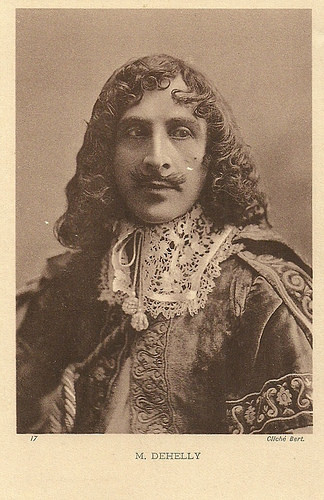
French postcard, no. 17. Photo: Cliché Bert. Publicity still for Les trois mousquetaires (Henri Puctal, André Calmettes, 1913) with Émile Dehelly as D'Artagnan.
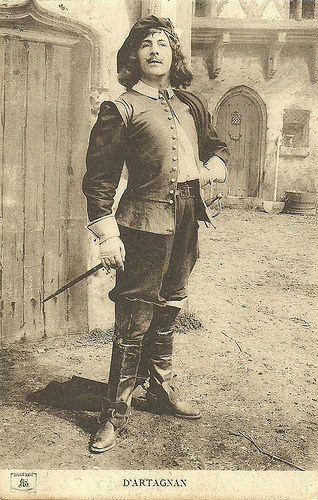
French postcard. Photo: publicity still for Les trois mousquetaires (Henri Puctal, André Calmettes, 1913) with Émile Dehelly as D'Artagnan.
Propaganda tours
Emile Léon Auguste Dehelly was born in 1871 in Fresnoy-le-Grand, France. At a young age he moved with his father to Epernon.
In 1893, he was drafted and performed his military service at the 102nd Infantry Regiment in Reuilly. Later, he remained a reservist, and Dehelly was drafted in 1915 for the 30th Territorial Regiment Chartres. He would be released in 1917, after which he focused on acting at the Théâtre aux Armées. He performed on propaganda tours in Norway and Sweden, and for interned soldiers in Switzerland.
In 1890 Dehelly entered the Comédie-Française. Between 1903 and 1928 he was sociétaire, a regular member of the organisation and as such receive a pension after 20 years of service. He acted mostly in the typical Comédie classics by Molière such as L'École des maris (The School for Husbands) but also plays by William Shakespeare and Victor Hugo.
In 1928 he became sociétaire honoraire and in 1931 he said goodbye to the Comédie. As a farewell he once more performed his famous role of Dorante in Le menteur (The Liar) by Pierre Corneille.
In 1909 Dehelly started to act at the newly founded Le Film d’Art, initially often under the direction of André Calmettes. He acted in several short films on historical characters who previously had inspired the stage and history painting (Delaroche et. al.).
Examples are Rival de son père/Rival to his father (André Calmettes, 1909), based on Friedrich Schiller’s Don Carlos, Louis XI (André Calmettes, 1909) with Rolla Norman , Héliogabale/Heliogabalus (André Calmettes, 1909), Les enfants d’Édouard/The Children of Edward IV (André Calmettes, 1910), La reine Margot/Queen Margot (Camille de Morlhon, 1910) with Berthe Bovy in the lead, and Camille Desmoulins (Henri Pouctal, 1911) with Dehelly himself in the lead.
At the Éclair company, Dehelly also acted in short comedies such as Un coup de vent/The gale (Émile Chautard, 1910) with Suzanne Goldstein, and Amour et science/Love and Science (?, 1912) with Renée Sylvaire .
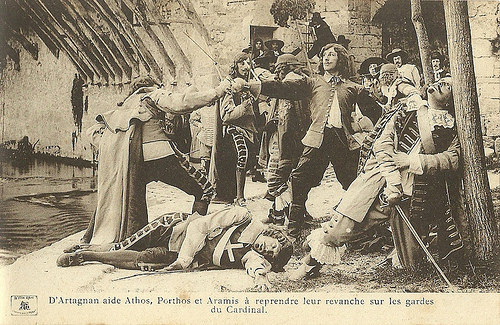
French postcard. Photo: publicity still for Les trois mousquetaires (Henri Puctal, André Calmettes, 1913) with Émile Dehelly as D'Artagnan, Marcel Vibert (Athos), Adolphe Candé (Porthos) and Stellio (Aramis).
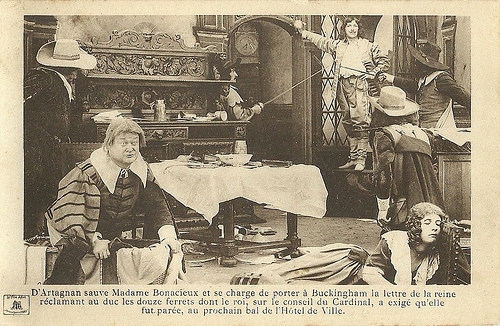
French postcard. Photo: publicity still for Les trois mousquetaires (Henri Puctal, André Calmettes, 1913) with Émile Dehelly as D'Artagnan and Guizelle as Constance Bonacieux (at right).
D’Artagnan
In 1913, Émile Dehelly had the lead as D’Artagnan in the two-part, lengthy feature film Les trois mousquetaires/The three musketeers, produced by Le Film d’Art.
André Calmettes had been replaced as the main director at the Film d'art by Henri Pouctal. With Pouctal he previously had acted in the short La comtesse Sarah, a Georges Ohnet adaptation, which starred Nelly Cormon, who would become Dehelly’s antagonist in Les trois mousquetaires as Milady De Winter.
Though Les trois mousquetaires was intensely promoted and internatonally well received, Dehelly stopped his film acting for some years.
He returned in only one more silent film, Graziella (Marcel Vandal, 1926), and two early sound films: Maurin des Maures (André Hugon, 1932), and Chair ardente/Burning flesh (René Plaisetty, 1932). In Graziella he played the writer Alphonse de Lamartine in his older years, while the young Lamartine was played by his own son Jean Dehelly, Graziella by Nina Vanna and Graziella’s lover Cecco by Antonin Artaud.
Chair ardente was director Plaisetty’s last film and was not a huge success. This may have contributed to the fact that Dehelly afterwards didn’t act in film anymore. He was past 60 by then and had already stopped at the Comédie française the year before.
His son Jean Dehelly, born in 1896, had a prolific career in French silent cinema of the 1920s. He also stopped his film acting in 1932. There may be a connection here.
Émile Dehelly died in 1969 in Paris, at the extreme high age of 98. He survived his son Jean by five years.
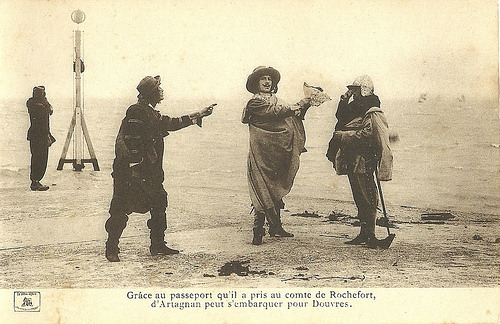
French postcard. Photo: publicity still for Les trois mousquetaires (Henri Puctal, André Calmettes, 1913) with Émile Dehelly as D'Artagnan.
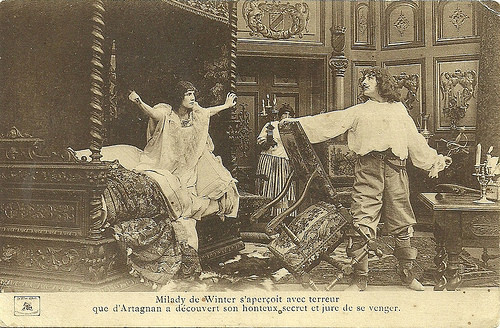
French postcard. Photo: publicity still for Les trois mousquetaires (Henri Puctal, André Calmettes, 1913) with Émile Dehelly as D'Artagnan and Nelly Cormon as Milady.
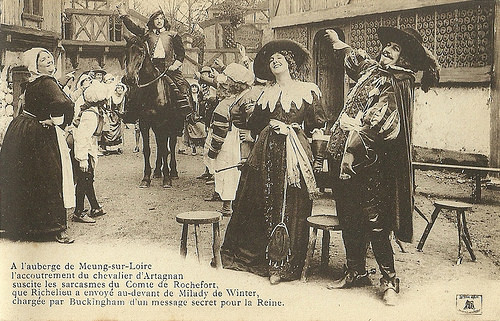
French postcard. Photo: publicity still for Les trois mousquetaires (Henri Puctal, André Calmettes, 1913) with Émile Dehelly as D'Artagnan and Jacques Volnys as Count De Rochefort.
Sources: Ciné-ressources (French), Gallica (French), INA (FRench), Wikipedia (French) and IMDb.
Watch also this television interview of 1958 in which a lively Dehelly recalls his work at the Comédie but also a radio performance of Le menteur he once did.

French postcard, no. 17. Photo: Cliché Bert. Publicity still for Les trois mousquetaires (Henri Puctal, André Calmettes, 1913) with Émile Dehelly as D'Artagnan.

French postcard. Photo: publicity still for Les trois mousquetaires (Henri Puctal, André Calmettes, 1913) with Émile Dehelly as D'Artagnan.
Propaganda tours
Emile Léon Auguste Dehelly was born in 1871 in Fresnoy-le-Grand, France. At a young age he moved with his father to Epernon.
In 1893, he was drafted and performed his military service at the 102nd Infantry Regiment in Reuilly. Later, he remained a reservist, and Dehelly was drafted in 1915 for the 30th Territorial Regiment Chartres. He would be released in 1917, after which he focused on acting at the Théâtre aux Armées. He performed on propaganda tours in Norway and Sweden, and for interned soldiers in Switzerland.
In 1890 Dehelly entered the Comédie-Française. Between 1903 and 1928 he was sociétaire, a regular member of the organisation and as such receive a pension after 20 years of service. He acted mostly in the typical Comédie classics by Molière such as L'École des maris (The School for Husbands) but also plays by William Shakespeare and Victor Hugo.
In 1928 he became sociétaire honoraire and in 1931 he said goodbye to the Comédie. As a farewell he once more performed his famous role of Dorante in Le menteur (The Liar) by Pierre Corneille.
In 1909 Dehelly started to act at the newly founded Le Film d’Art, initially often under the direction of André Calmettes. He acted in several short films on historical characters who previously had inspired the stage and history painting (Delaroche et. al.).
Examples are Rival de son père/Rival to his father (André Calmettes, 1909), based on Friedrich Schiller’s Don Carlos, Louis XI (André Calmettes, 1909) with Rolla Norman , Héliogabale/Heliogabalus (André Calmettes, 1909), Les enfants d’Édouard/The Children of Edward IV (André Calmettes, 1910), La reine Margot/Queen Margot (Camille de Morlhon, 1910) with Berthe Bovy in the lead, and Camille Desmoulins (Henri Pouctal, 1911) with Dehelly himself in the lead.
At the Éclair company, Dehelly also acted in short comedies such as Un coup de vent/The gale (Émile Chautard, 1910) with Suzanne Goldstein, and Amour et science/Love and Science (?, 1912) with Renée Sylvaire .

French postcard. Photo: publicity still for Les trois mousquetaires (Henri Puctal, André Calmettes, 1913) with Émile Dehelly as D'Artagnan, Marcel Vibert (Athos), Adolphe Candé (Porthos) and Stellio (Aramis).

French postcard. Photo: publicity still for Les trois mousquetaires (Henri Puctal, André Calmettes, 1913) with Émile Dehelly as D'Artagnan and Guizelle as Constance Bonacieux (at right).
D’Artagnan
In 1913, Émile Dehelly had the lead as D’Artagnan in the two-part, lengthy feature film Les trois mousquetaires/The three musketeers, produced by Le Film d’Art.
André Calmettes had been replaced as the main director at the Film d'art by Henri Pouctal. With Pouctal he previously had acted in the short La comtesse Sarah, a Georges Ohnet adaptation, which starred Nelly Cormon, who would become Dehelly’s antagonist in Les trois mousquetaires as Milady De Winter.
Though Les trois mousquetaires was intensely promoted and internatonally well received, Dehelly stopped his film acting for some years.
He returned in only one more silent film, Graziella (Marcel Vandal, 1926), and two early sound films: Maurin des Maures (André Hugon, 1932), and Chair ardente/Burning flesh (René Plaisetty, 1932). In Graziella he played the writer Alphonse de Lamartine in his older years, while the young Lamartine was played by his own son Jean Dehelly, Graziella by Nina Vanna and Graziella’s lover Cecco by Antonin Artaud.
Chair ardente was director Plaisetty’s last film and was not a huge success. This may have contributed to the fact that Dehelly afterwards didn’t act in film anymore. He was past 60 by then and had already stopped at the Comédie française the year before.
His son Jean Dehelly, born in 1896, had a prolific career in French silent cinema of the 1920s. He also stopped his film acting in 1932. There may be a connection here.
Émile Dehelly died in 1969 in Paris, at the extreme high age of 98. He survived his son Jean by five years.

French postcard. Photo: publicity still for Les trois mousquetaires (Henri Puctal, André Calmettes, 1913) with Émile Dehelly as D'Artagnan.

French postcard. Photo: publicity still for Les trois mousquetaires (Henri Puctal, André Calmettes, 1913) with Émile Dehelly as D'Artagnan and Nelly Cormon as Milady.

French postcard. Photo: publicity still for Les trois mousquetaires (Henri Puctal, André Calmettes, 1913) with Émile Dehelly as D'Artagnan and Jacques Volnys as Count De Rochefort.
Sources: Ciné-ressources (French), Gallica (French), INA (FRench), Wikipedia (French) and IMDb.
Watch also this television interview of 1958 in which a lively Dehelly recalls his work at the Comédie but also a radio performance of Le menteur he once did.
Published on June 07, 2015 22:00
June 6, 2015
Pierre Brice (1929-2015)
Pierre Brice, the French actor who fascinated millions of European film fans in his role as Apache chief Winnetou, has died. The handsome Brice (1929-2015) was the hero of 11 films based on German author Karl May's tales of America's colonization. During the 1960s, Winnetou - a long-haired saint with a gun - was a superstar among European kids. Brice died in a clinic near Paris. He was 86.
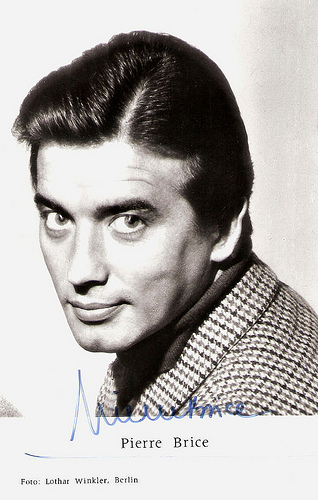
German autograph card. Photo: Lothar Winkler.
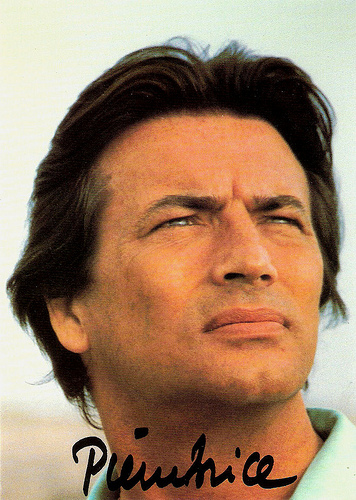
German postcard by Schorsch und Söhne, Kulmbach.
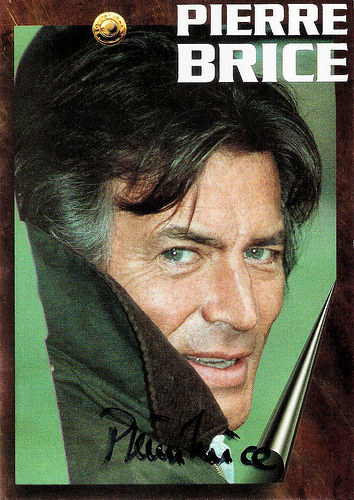
German promotion card by Herz Klang for the record Gefühle. Photo: Frank Wunderlich.
Paratrooper In Indochina
Pierre Brice was born into nobility as Baron Pierre Louis de Bris in Brest, France, in 1929. He was 11 years old when the Nazis invaded France. Since he was brought up a patriot, he joined his father in the Résistance at age 15. When he was 19, he enlisted as a volunteer in the French Army and fought four years as a paratrooper in Indochina.
In 1951, Brice returned from the war. He turned his life around and became an actor. He took acting classes from the Russian actor Gregori Chmara . He became a model for advertisements and photo novels, acted as a door-to-door salesman and traveled with a circus.
He got his first small film role in the Eddie Constantine thriller Ça va barder/Give 'em Hell (John Berry, Jacques Lamare, 1955). Bigger roles followed in French productions like Les Tricheurs/Youthful Sinners (Marcel Carné, 1958), but his career in France wasn't likely to take off. He simply did not have the same kind of talents and charisma as Alain Delon (to whom he was sometimes compared), nor did his good looks go down too well with the (then booming) Nouvelle Vague.
Brice was more a typical matinée idol, he was well-built and very handsome. He could easily pull off any kind of adventurer and he looked convincingly in period costume. Brice went to Italy, to appear in the Peplums, the sword and sandal films and similar adventure films like the Gothic horror shocker Il Mulino delle donne di pietra/Mill of the Stone Women (Giorgio Ferroni, 1960), and the modern day crime film Il Rossetto/Red Lips (Damiano Damiani, 1960).
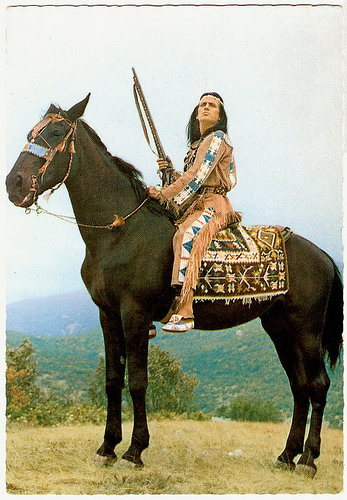
German postcard, no. E 74. Photo: Constantin. Publicity Still for Der Schatz im Silbersee/Treasure of Silver Lake (1962).
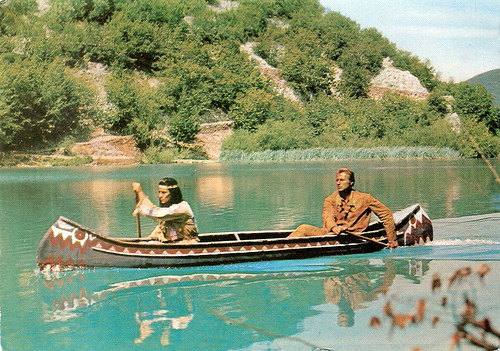
Dutch postcard by Gebr. Spanjersberg N.V., Rotterdam/Edition Facet Publishers. Photo: Rank Film Publishers (Holland) N.V. Publicity Still for Der Schatz im Silbersee/Treasure of Silver Lake (1962) with Lex Barker as Old Shatterhand.
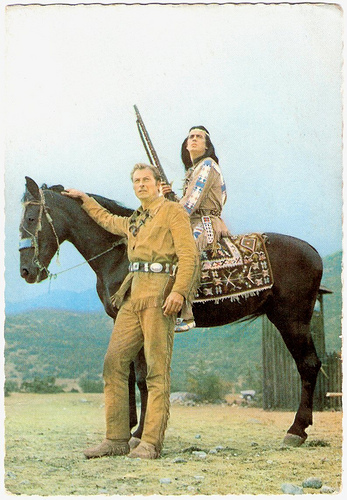
German postcard, no. ED 52. Photo: Constantin. Still from Der Schatz im Silbersee/Treasure of Silver Lake (1962).
Winnetou
In 1962 at the Berlin Film Festival, Pierre Brice met the German producer Horst Wendlandt, head of Rialto Film. Wendlandt searched for an actor to play a Native American chief in Der Schatz im Silbersee/Treasure of Silver Lake (Harald Reinl, 1962).
Blogger Mike Haberfelner wonders why Wendlandt thought that Pierre Brice would be right for the role: "Sure, Brice was a suitably handsome actor for such a role and he had proven himself as a heroic lead time and again, but he was also almost unknown in Germany and he looked nothing like a Native American." Brice gave a passionate interpretation of Winnetou, and according to Haberfelner his impact easily overshadowed his co-star, Hollywood veteran Lex Barker , who as Old Shatterhand was first-billed in the credits.
Der Schatz im Silbersee was the first filmisation of a novel by Karl May (1842-1912) set in the American West. Earlier films after his novels, like Die Teufelsanbeter/The Devil Worshippers (Marie Luise Droop, 1920) and Die Sklavenkarawane/The Caravan of Slaves (Georg Marischka, Ramón Torrado, 1958), were all set in the Near East.
Der Schatz im Silbersee was a co-production of Germany, Yugoslavia and France. Principal shooting took place in national park Paklenica Karst River Canyon, Yugoslavia now Croatia. Marianne Hoppe had her first international film role, and for the laughs Eddi Arent (Lord Castlepool) and Ralf Wolter (Trapper Sam Hawkins) appeared. British actor Herbert Lom was cast as a bad colonel, but his performance was restricted by the script.
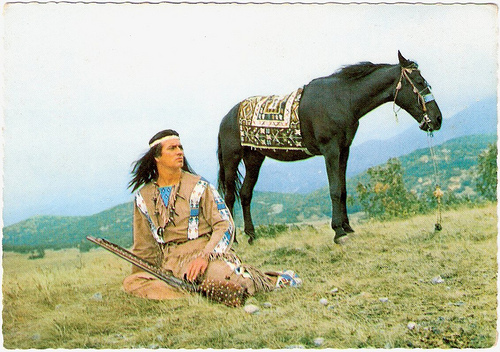
German postcard, no. ED 51. Photo: Constantin. Still from Der Schatz im Silbersee (1962).
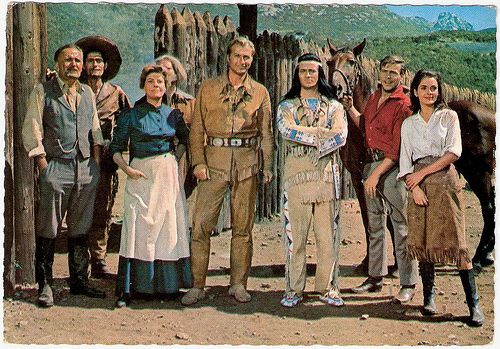
German postcard, no. ED 62. Photo: Constantin. Still from Der Schatz im Silbersee (1962).
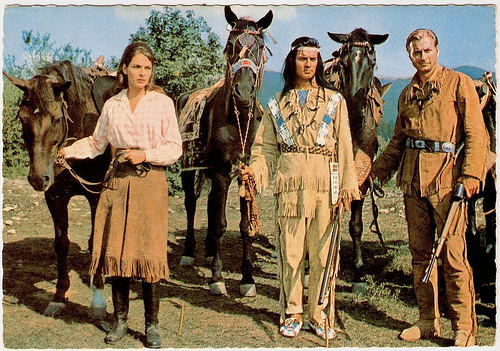
Karin Dor, Lex Barker, Pierre Brice in Der Schatz im Silbersee. German postcard, no. ED 64. Photo: Constantin. Still from Der Schatz im Silbersee (1962).
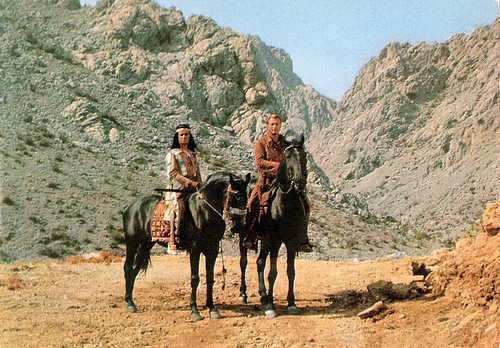
Dutch postcard by Facet Publishers, Lunteren, no. 4. Photo: Rank Film Distributors (Holland) N.V. Publicity still from Der Schatz im Silbersee (1962).
A Superstar in West Germany
Der Schatz im Silbersee has a larger-than-life, fairy tale like atmosphere that attracted a huge audience. It was the very first German film to receive the Goldene Leinwand (Golden Screen), for having over 3 million visitors within 12 months. The film also received the Bambi-award 1963 as best box-office-production. It received furthermore a sum of 200.000 DM from the government as a film-prize.
The Old Shatterhand-Melodie, the title melody played on the harmonica by René Giessen and composed by Martin Böttcher, was the most successful track in the German hitparades during the 1960s. It stayed there for several months and over 100,000 copies were sold.
For that time this was very unusual, especially for a film music-track without any singers. The music was accompanied by members of the symphony-orchestra of the Norddeutscher Rundfunk. Later the theme was recorded as a vocal track by several singers, including a version by Pierre Brice.
Suddenly, Pierre Brice, who was virtually unknown in his homecountry and was barely holding his own in Italy, was a superstar in West Germany.

German postcard , no. E 2. Photo: Constantin. Publicity Still for Winnetou I.Teil/Apache Gold (1963).
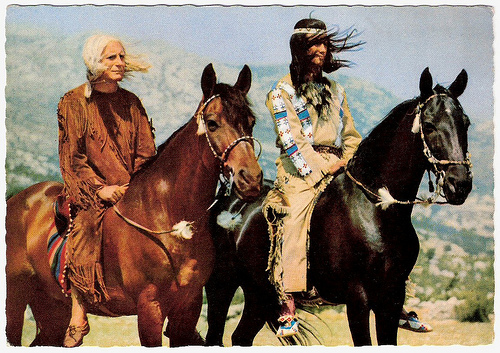
Pierre Brice and Hrvoje Svob. German postcard, no. E 14. Photo: Constantin. Still from Winnetou I/Winnetou (1963).
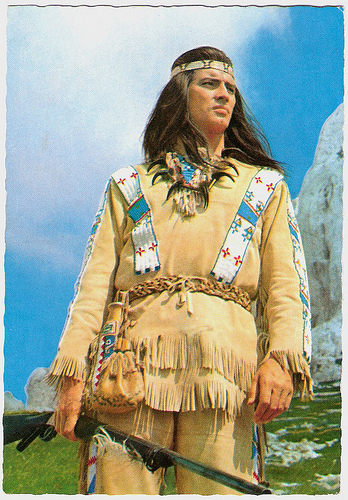
German postcard, no. E 5. Photo: Constantin. Still from Winnetou I/Winnetou (1963).
Blood Brothers
Der Schatz im Silbersee was the first Winnetou western, but it is set in time after the next film in the Winnetou series, Winnetou – 1. TeilApache Gold (Harald Reinl, 1963), again with a music score by Martin Böttcher.
Winnetou – 1. Teil, also starred Marie Versini as Winnetou's sister, Mario Adorf as the main villain and Croatian beauty Dunja Rajter.
The film depicts the first meeting of Winnetou and Old Shatterhand, but initially they find themselves fighting on opposite sides, and it takes the whole film (and a love story between Old Shatterhand and Winnetou's sister) until they realize each other's righteousness and become friends and blood brothers.
Pierre Brice would go on to portray Winnetou in a total of eleven films, alongside alternatively Lex Barker (Old Shatterhand in 7 films), Stewart Granger (Old Surehand in 3 films), and Rod Cameron (1 film) as the white heroes. All these Westerns were based on the Karl May books and were produced between 1962 and 1968.
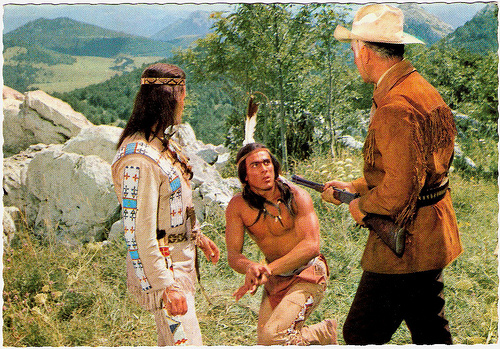
Pierre Brice, Stewart Granger and Gojko Mitic . German postcard, no. 10. Photo: Constantin. Publicity still for Unter Geiern/Among Vultures (1964).
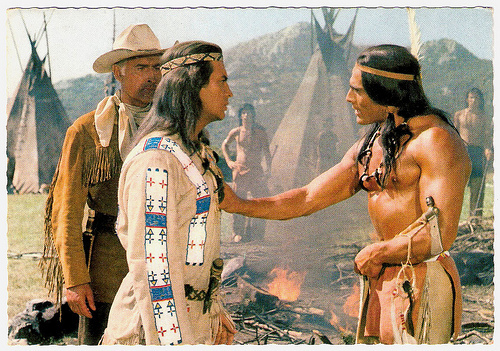
German postcard, no. 35. Photo: Constantin. Publicity still for Unter Geiern/Among Vultures (1964).
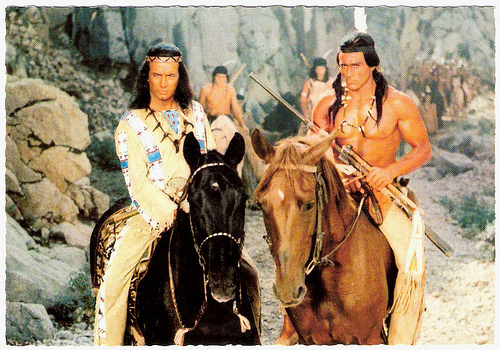
German postcard, no. 40. Photo: Constantin. Publicity still for Unter Geiern/Among Vultures (1964).
Peplum Spectacle
Pierre Brice appeared also in several other European films like Zorro contro Maciste/Samson and the Slave Queen (Umberto Lenzi, 1963), with Lex Barker in the non-Karl May film Die Hölle von Manitoba/A Place Called Glory (Sheldon Reynolds, 1965), the James Bond rip-off Schüsse im Dreivierteltakt/Operation Solo (Alfred Weidenmann, 1965), and the Peplum spectacle Dacii/The Dacians (Sergiu Nicolaescu, 1967) with Marie-José Nat .
In the anthology film Gern hab' ich die Frauen gekillt/Le Carnaval des barbouzes/Killer's Carnival (Sheldon Reynolds a.o., 1966) Stewart Granger , Lex Barker and Pierre Brice finally worked together - but for some reason, the three actors did not share a single scene in the film.
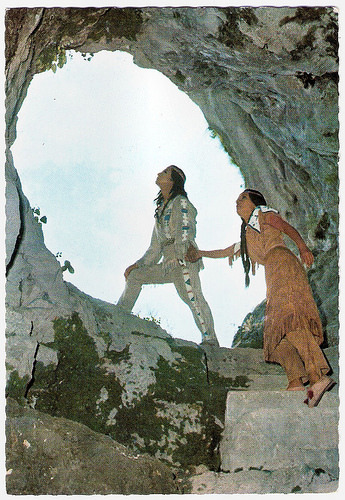
German postcard, no R 8. Photo: publicity still for Winnetou 2. Teil/Winnetou: The Red Gentleman (Harald Reinl, 1964) with Karin Dor .
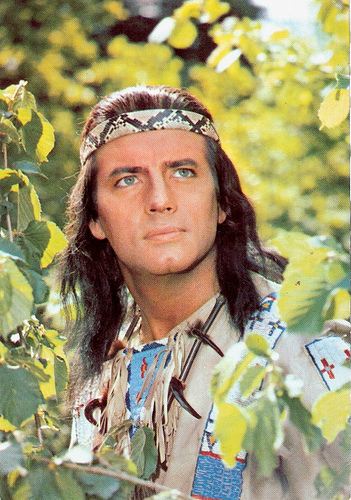
German postcard by ISV, no. R 14. Photo: publicity still for Winnetou - 2. Teil/Last of the Renegades (1964).
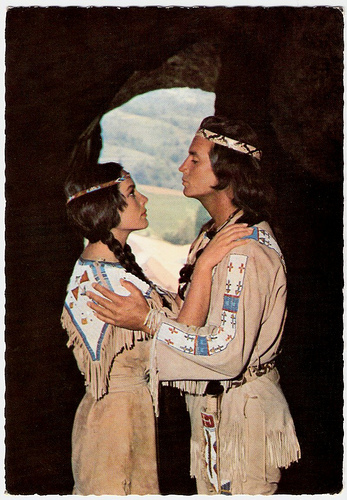
Karin Dor and Pierre Brice. German postcard, no. R 24. Photo: still from Winnetou - 2. Teil/Last of the Renegades (1964).
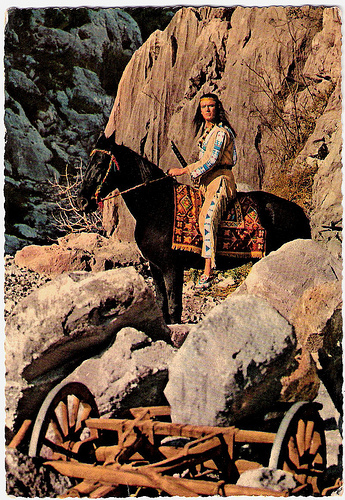
German postcard by Krüger. Photo: Bernard of Hollywood / CCC Produktion. Publicity still for Old Shattterhand (1964). Sent by mail in Luxemburg in 1966.
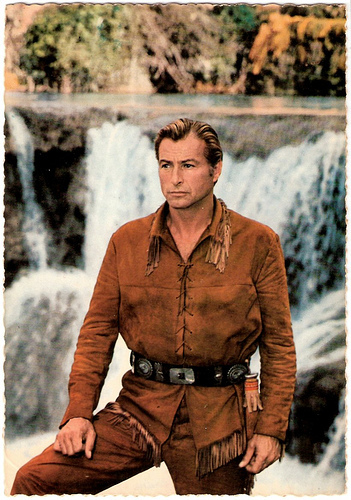
Lex Barker . German postcard by Kruger. Photo: Bernard of Hollywood (Bruno Bernard) / CCC-Produktion. Publicity still for Old Shatterhand (1964).
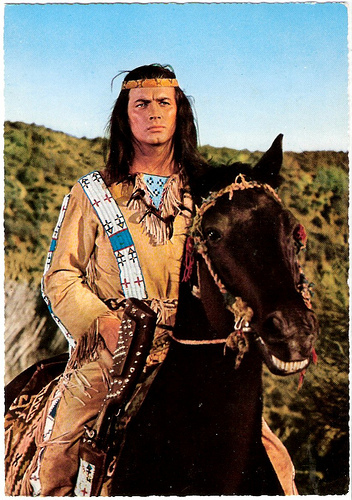
German postcard by Kruger. Photo: Bruno Bernard / CCC Produktion. Publicity Still for Old Shatterhand (1964).
Karl May Shows
During the 1970s, Pierre Brice played in supporting parts in films like the crime comedy La Pupa del Gangster/Get Rita (Giorgio Capitani, 1975), starring Marcello Mastroianni and Sophia Loren.
He also appeared in several TV shows like the Sci-Fi series Star Maidens (1976). But he will always be best remembered as Winnetou, whom he also played at the Karl May Festspiele in Elspe (1977-1986) and at the Bad Segeberg open air theater, dedicated only to productions of Karl May shows (1988-1991).
In 1979 he played Winnetou - with Siegfried Rauch as Old Shatterhand - in the TV series Winnetou le mescalero/My Friend Winnetou (Marcel Camus, 1980), which did not originate from Karl May material.
At age 69, he again acted in – and co-scripted - a TV mini series Winnetous Rückkehr/Winnetou's Return (Marijan David Vajda, 1998), which met devastating criticism.
Last Friday, 5 June 2015, the 86-years-old Brice was admitted to hospital with a high fever from a lung infection and he died early on Saturday in the arms of his wife, Hella Krekel. The pair, who lived for three decades in a country house 60 kilometers from Paris, had long been planning a return to her home state of Bavaria.
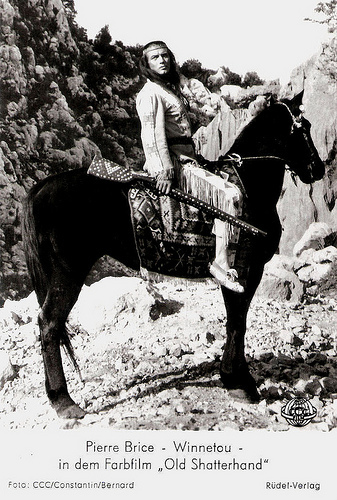
German postcard by Rüdel-Verlag. Photo: CCC / Constantin / Bruno Bernard. Publicity Still for Old Shatterhand (1964).
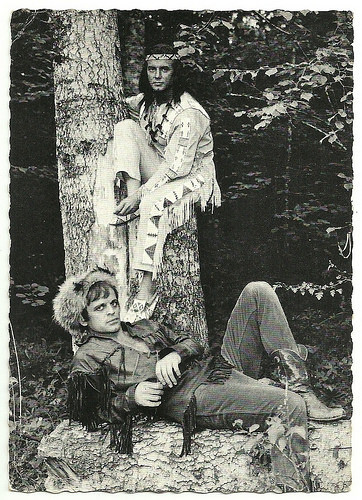
With Klaus Kinski . German postcard by Filmbilder-Vertrieb Ernst Freihoff, Essen. Photo: Lothar Winkler.
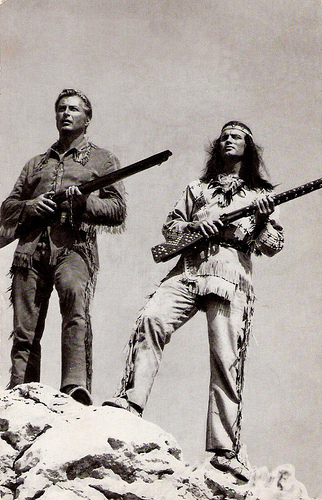
Vintage Dutch postcard. With Lex Barker .
US trailer for Il mulino delle donne di pietra/Mill of the Stone Women (1963). Source: Cult of the Cinema (YouTube).
Trailer for Winnetou - 2. Teil/Last of the Renegades (1964). Source: RialtoFilm (YouTube).
Scene from Winnetous Rückkehr/Winnetou's Return (1998). Source: SebastianVader (YouTube).
Sources: Mike Haberfelner ((Re)search My Trash), Deutsche Welle, Wikipedia and .

German autograph card. Photo: Lothar Winkler.

German postcard by Schorsch und Söhne, Kulmbach.

German promotion card by Herz Klang for the record Gefühle. Photo: Frank Wunderlich.
Paratrooper In Indochina
Pierre Brice was born into nobility as Baron Pierre Louis de Bris in Brest, France, in 1929. He was 11 years old when the Nazis invaded France. Since he was brought up a patriot, he joined his father in the Résistance at age 15. When he was 19, he enlisted as a volunteer in the French Army and fought four years as a paratrooper in Indochina.
In 1951, Brice returned from the war. He turned his life around and became an actor. He took acting classes from the Russian actor Gregori Chmara . He became a model for advertisements and photo novels, acted as a door-to-door salesman and traveled with a circus.
He got his first small film role in the Eddie Constantine thriller Ça va barder/Give 'em Hell (John Berry, Jacques Lamare, 1955). Bigger roles followed in French productions like Les Tricheurs/Youthful Sinners (Marcel Carné, 1958), but his career in France wasn't likely to take off. He simply did not have the same kind of talents and charisma as Alain Delon (to whom he was sometimes compared), nor did his good looks go down too well with the (then booming) Nouvelle Vague.
Brice was more a typical matinée idol, he was well-built and very handsome. He could easily pull off any kind of adventurer and he looked convincingly in period costume. Brice went to Italy, to appear in the Peplums, the sword and sandal films and similar adventure films like the Gothic horror shocker Il Mulino delle donne di pietra/Mill of the Stone Women (Giorgio Ferroni, 1960), and the modern day crime film Il Rossetto/Red Lips (Damiano Damiani, 1960).

German postcard, no. E 74. Photo: Constantin. Publicity Still for Der Schatz im Silbersee/Treasure of Silver Lake (1962).

Dutch postcard by Gebr. Spanjersberg N.V., Rotterdam/Edition Facet Publishers. Photo: Rank Film Publishers (Holland) N.V. Publicity Still for Der Schatz im Silbersee/Treasure of Silver Lake (1962) with Lex Barker as Old Shatterhand.

German postcard, no. ED 52. Photo: Constantin. Still from Der Schatz im Silbersee/Treasure of Silver Lake (1962).
Winnetou
In 1962 at the Berlin Film Festival, Pierre Brice met the German producer Horst Wendlandt, head of Rialto Film. Wendlandt searched for an actor to play a Native American chief in Der Schatz im Silbersee/Treasure of Silver Lake (Harald Reinl, 1962).
Blogger Mike Haberfelner wonders why Wendlandt thought that Pierre Brice would be right for the role: "Sure, Brice was a suitably handsome actor for such a role and he had proven himself as a heroic lead time and again, but he was also almost unknown in Germany and he looked nothing like a Native American." Brice gave a passionate interpretation of Winnetou, and according to Haberfelner his impact easily overshadowed his co-star, Hollywood veteran Lex Barker , who as Old Shatterhand was first-billed in the credits.
Der Schatz im Silbersee was the first filmisation of a novel by Karl May (1842-1912) set in the American West. Earlier films after his novels, like Die Teufelsanbeter/The Devil Worshippers (Marie Luise Droop, 1920) and Die Sklavenkarawane/The Caravan of Slaves (Georg Marischka, Ramón Torrado, 1958), were all set in the Near East.
Der Schatz im Silbersee was a co-production of Germany, Yugoslavia and France. Principal shooting took place in national park Paklenica Karst River Canyon, Yugoslavia now Croatia. Marianne Hoppe had her first international film role, and for the laughs Eddi Arent (Lord Castlepool) and Ralf Wolter (Trapper Sam Hawkins) appeared. British actor Herbert Lom was cast as a bad colonel, but his performance was restricted by the script.

German postcard, no. ED 51. Photo: Constantin. Still from Der Schatz im Silbersee (1962).

German postcard, no. ED 62. Photo: Constantin. Still from Der Schatz im Silbersee (1962).

Karin Dor, Lex Barker, Pierre Brice in Der Schatz im Silbersee. German postcard, no. ED 64. Photo: Constantin. Still from Der Schatz im Silbersee (1962).

Dutch postcard by Facet Publishers, Lunteren, no. 4. Photo: Rank Film Distributors (Holland) N.V. Publicity still from Der Schatz im Silbersee (1962).
A Superstar in West Germany
Der Schatz im Silbersee has a larger-than-life, fairy tale like atmosphere that attracted a huge audience. It was the very first German film to receive the Goldene Leinwand (Golden Screen), for having over 3 million visitors within 12 months. The film also received the Bambi-award 1963 as best box-office-production. It received furthermore a sum of 200.000 DM from the government as a film-prize.
The Old Shatterhand-Melodie, the title melody played on the harmonica by René Giessen and composed by Martin Böttcher, was the most successful track in the German hitparades during the 1960s. It stayed there for several months and over 100,000 copies were sold.
For that time this was very unusual, especially for a film music-track without any singers. The music was accompanied by members of the symphony-orchestra of the Norddeutscher Rundfunk. Later the theme was recorded as a vocal track by several singers, including a version by Pierre Brice.
Suddenly, Pierre Brice, who was virtually unknown in his homecountry and was barely holding his own in Italy, was a superstar in West Germany.

German postcard , no. E 2. Photo: Constantin. Publicity Still for Winnetou I.Teil/Apache Gold (1963).

Pierre Brice and Hrvoje Svob. German postcard, no. E 14. Photo: Constantin. Still from Winnetou I/Winnetou (1963).

German postcard, no. E 5. Photo: Constantin. Still from Winnetou I/Winnetou (1963).
Blood Brothers
Der Schatz im Silbersee was the first Winnetou western, but it is set in time after the next film in the Winnetou series, Winnetou – 1. TeilApache Gold (Harald Reinl, 1963), again with a music score by Martin Böttcher.
Winnetou – 1. Teil, also starred Marie Versini as Winnetou's sister, Mario Adorf as the main villain and Croatian beauty Dunja Rajter.
The film depicts the first meeting of Winnetou and Old Shatterhand, but initially they find themselves fighting on opposite sides, and it takes the whole film (and a love story between Old Shatterhand and Winnetou's sister) until they realize each other's righteousness and become friends and blood brothers.
Pierre Brice would go on to portray Winnetou in a total of eleven films, alongside alternatively Lex Barker (Old Shatterhand in 7 films), Stewart Granger (Old Surehand in 3 films), and Rod Cameron (1 film) as the white heroes. All these Westerns were based on the Karl May books and were produced between 1962 and 1968.

Pierre Brice, Stewart Granger and Gojko Mitic . German postcard, no. 10. Photo: Constantin. Publicity still for Unter Geiern/Among Vultures (1964).

German postcard, no. 35. Photo: Constantin. Publicity still for Unter Geiern/Among Vultures (1964).

German postcard, no. 40. Photo: Constantin. Publicity still for Unter Geiern/Among Vultures (1964).
Peplum Spectacle
Pierre Brice appeared also in several other European films like Zorro contro Maciste/Samson and the Slave Queen (Umberto Lenzi, 1963), with Lex Barker in the non-Karl May film Die Hölle von Manitoba/A Place Called Glory (Sheldon Reynolds, 1965), the James Bond rip-off Schüsse im Dreivierteltakt/Operation Solo (Alfred Weidenmann, 1965), and the Peplum spectacle Dacii/The Dacians (Sergiu Nicolaescu, 1967) with Marie-José Nat .
In the anthology film Gern hab' ich die Frauen gekillt/Le Carnaval des barbouzes/Killer's Carnival (Sheldon Reynolds a.o., 1966) Stewart Granger , Lex Barker and Pierre Brice finally worked together - but for some reason, the three actors did not share a single scene in the film.

German postcard, no R 8. Photo: publicity still for Winnetou 2. Teil/Winnetou: The Red Gentleman (Harald Reinl, 1964) with Karin Dor .

German postcard by ISV, no. R 14. Photo: publicity still for Winnetou - 2. Teil/Last of the Renegades (1964).

Karin Dor and Pierre Brice. German postcard, no. R 24. Photo: still from Winnetou - 2. Teil/Last of the Renegades (1964).

German postcard by Krüger. Photo: Bernard of Hollywood / CCC Produktion. Publicity still for Old Shattterhand (1964). Sent by mail in Luxemburg in 1966.

Lex Barker . German postcard by Kruger. Photo: Bernard of Hollywood (Bruno Bernard) / CCC-Produktion. Publicity still for Old Shatterhand (1964).

German postcard by Kruger. Photo: Bruno Bernard / CCC Produktion. Publicity Still for Old Shatterhand (1964).
Karl May Shows
During the 1970s, Pierre Brice played in supporting parts in films like the crime comedy La Pupa del Gangster/Get Rita (Giorgio Capitani, 1975), starring Marcello Mastroianni and Sophia Loren.
He also appeared in several TV shows like the Sci-Fi series Star Maidens (1976). But he will always be best remembered as Winnetou, whom he also played at the Karl May Festspiele in Elspe (1977-1986) and at the Bad Segeberg open air theater, dedicated only to productions of Karl May shows (1988-1991).
In 1979 he played Winnetou - with Siegfried Rauch as Old Shatterhand - in the TV series Winnetou le mescalero/My Friend Winnetou (Marcel Camus, 1980), which did not originate from Karl May material.
At age 69, he again acted in – and co-scripted - a TV mini series Winnetous Rückkehr/Winnetou's Return (Marijan David Vajda, 1998), which met devastating criticism.
Last Friday, 5 June 2015, the 86-years-old Brice was admitted to hospital with a high fever from a lung infection and he died early on Saturday in the arms of his wife, Hella Krekel. The pair, who lived for three decades in a country house 60 kilometers from Paris, had long been planning a return to her home state of Bavaria.

German postcard by Rüdel-Verlag. Photo: CCC / Constantin / Bruno Bernard. Publicity Still for Old Shatterhand (1964).

With Klaus Kinski . German postcard by Filmbilder-Vertrieb Ernst Freihoff, Essen. Photo: Lothar Winkler.

Vintage Dutch postcard. With Lex Barker .
US trailer for Il mulino delle donne di pietra/Mill of the Stone Women (1963). Source: Cult of the Cinema (YouTube).
Trailer for Winnetou - 2. Teil/Last of the Renegades (1964). Source: RialtoFilm (YouTube).
Scene from Winnetous Rückkehr/Winnetou's Return (1998). Source: SebastianVader (YouTube).
Sources: Mike Haberfelner ((Re)search My Trash), Deutsche Welle, Wikipedia and .
Published on June 06, 2015 22:00
June 5, 2015
Anna Boleyn (1920)
Anna Boleyn/Anne Boleyn (1920) is one of the silent historical films directed in Germany by the young Ernst Lubitsch. Henny Porten starred as the ill-fated Anne Boleyn and Emil Jannings as King Henry VIII. Ross Verlag published a wonderful series of sepia postcards of the film, often with photos by the Rembrandt studio in Berlin.
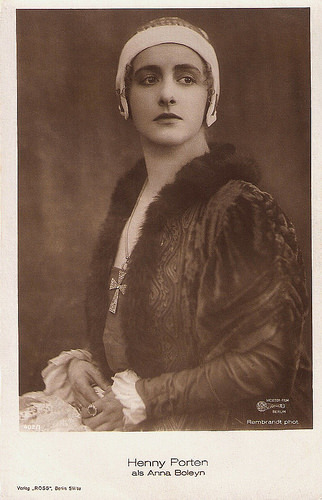
German postcard by Ross Verlag, Berlin, no. 402/1, 1919-1924. Photo: Rembrandt Phot. / Messter Film, Berlin. Publicity still for Anna Boleyn (Ernst Lubitsch, 1920).
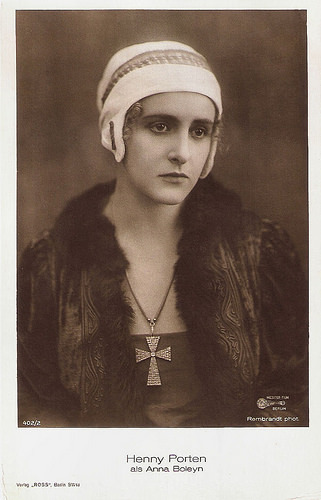
German postcard by Ross Verlag, Berlin, no. 402/2, 1919-1924. Photo: Rembrandt Phot. / Messter Film, Berlin. Publicity still for Anna Boleyn (Ernst Lubitsch, 1920).
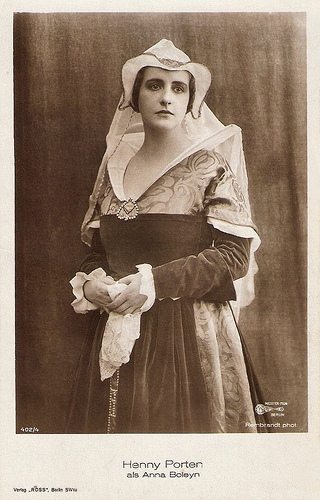
German postcard by Ross Verlag, Berlin, no. 402/4, 1919-1924. Photo: Rembrandt Phot. / Messter Film, Berlin. Publicity still for Anna Boleyn (Ernst Lubitsch, 1920) with Henny Porten .
The Bad Tempered King of England
Anne Boleyn was the second wife of King Henry VIII of England. Their marriage led to momentous political and religious turmoil. For Ernst Lubitsch ' film the script was written by Norbert Falk (as Fred Orbing) and Hanns Kräly.
Lubitsch presents Anna ( Henny Porten ) as an innocent, a naïve and guileless young woman who is the newly arrived lady-in-waiting to the Queen. She catches the lustful eye of Henry VIII ( Emil Jannings ), who loves to feast, drink, hunt, and chase around after young beauties. He is tired of Queen to Catherine of Aragon (Hedwig Pauly-Winterstein), and annuls his marriage to her, against the wishes of the pope.
The pompous monarch breaks with Rome, forms the Church of England and marries Anne at the Cathedral. The marriage and the sumptuous festivities that follow are filmed by Lubitsch as spectacular crowd scenes.
Henry tells Anne it is her holy duty to produce a male heir to the throne. But when Anne only gives birth to a baby girl (the later Queen Elizabeth), Henry VIII soon has his eye on yet another lady-in-waiting, Jane Seymour ( Aud Egede Nissen ).
The bad-tempered King charges his wife with adultery and treason, and imprisons her in the Tower of London. Anne is tortured and confesses to infidelity. She is sentenced to death and at in the final scene of the film she is beheaded.
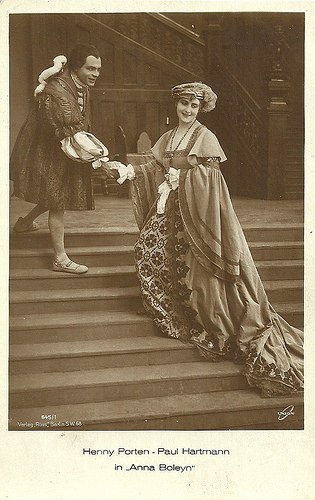
German postcard by Ross Verlag, Berlin, no. 645/1, 1919-1924. Photo: Union. Publicity still for Anna Boleyn (Ernst Lubitsch, 1920) with Henny Porten and Paul Hartmann .
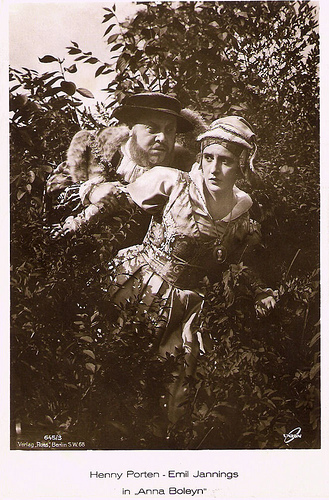
German postcard by Ross Verlag, Berlin, no. 645/3, 1919-1924. Photo: Union Film.
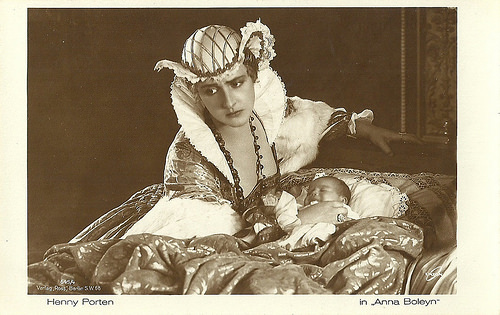
German postcard by Ross Verlag, Berlin, no. 645/4, 1919-1924. Photo: Union Film. The baby represents the future queen Elizabeth I.
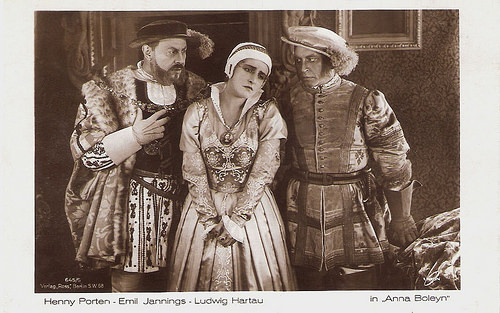
German postcard by Ross Verlag, Berlin, no. 645/5, 1919-1924. Photo: Union. Publicity still for Anna Boleyn (Ernst Lubitsch, 1920) with Emil Jannings , Henny Porten and Ludwig Hartau as the Duke of Norfolk.
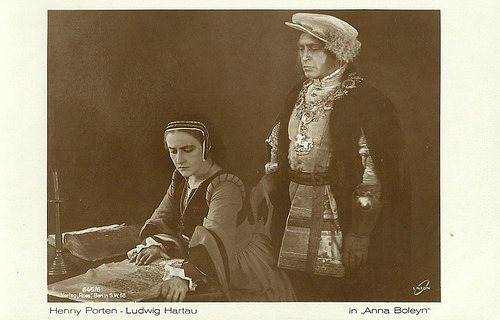
German postcard by Ross Verlag, Berlin, no. 645/6, 1919-1924. Photo: Union. Publicity still for Anna Boleyn (Ernst Lubitsch, 1920) with Henny Porten and Ludwig Hartau.
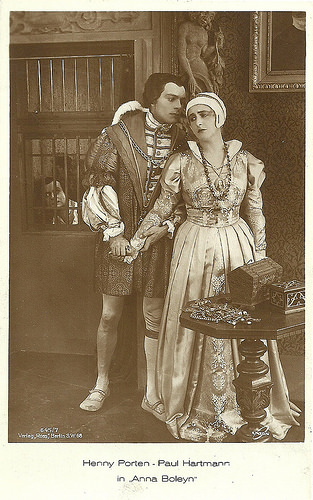
German postcard by Ross Verlag, Berlin, no. 645/7, 1919-1924. Photo: Union. Publicity still for Anna Boleyn (Ernst Lubitsch, 1920) with Henny Porten and Paul Hartmann .
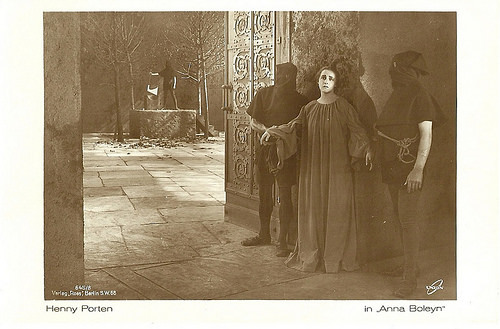
German postcard by Ross Verlag, no. 645/8, 1919-1924. Photo: Union. Publicity still for Anna Boleyn (Ernst Lubitsch, 1920) with Henny Porten .
The time is worth spending
In Anne Boleyn, Ernst Lubitsch lets his characters breathe and reveal their corruption down to the tiniest of meannesses. He takes his time, which can try the patience of an audience accustomed to being carried away by action, but the time is worth spending.
A beautiful aspect of Anne Boleyn are the very lavish medieval costuming and the large and elaborate exterior and interior sets. The outdoor scenes are impressive for 1920: a court sports event, Anna’s coronation, a Spring Festival, a hunt, a joust, and even a street battle outside the cathedral.
Emil Jannings is striking and memorable as King Henry the Eighth. He seems to have stepped straight out of Hans Holbein's famous portrait of King Henry VIII.
To introduce the king, Lubitsch uses one of his favourite comedy techniques: the pull-back-and-reveal. A year earlier, he had used this technique in the opening shot of Die Austernprinzessin/The Oyster Princess (1919) to show the bloated Oyster King surrounded by his lackeys. That shot is duplicated here and the look is slightly more realistic but just as revelatory of the character.
Anna Boleyn’s innocence is underlined by Lubitsch through the contrast with the very different character of Jane Seymour ( Aud Egede Nissen ). Jane is in a sense a mirror image in negative of Anna ( Henny Porten ). In the late confrontation between the two Jane claims that she serves Anna, but Lubitsch once again positions Anna as innocent: here, dressed in a simple nightdress, Anna kneels before the haughty Jane in her fine clothes.
Ernst Lubitsch constantly composes shots in depth in Anna Boleyn, looking down corridors or through into larger rooms, from the early moments at the harbour where a set of doors are opened onto a bustling street, to the haunting final view of the scaffold.
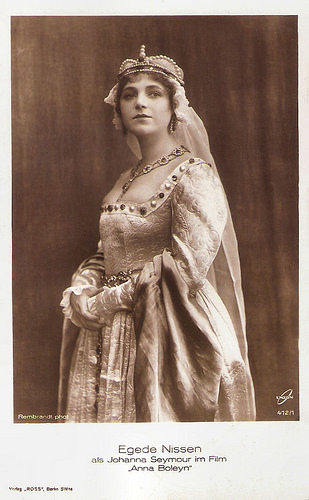
German postcard by Ross Verlag, Berlin, no. 472/1, 1919-1924. Photo: Rembrandt Phot. / Union Film with Aud Egede Nissen
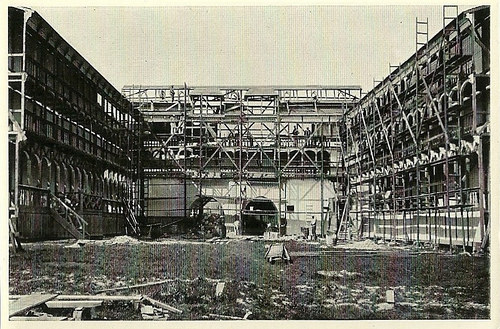
Ufa Tempelhof studio, set for Anna Boleyn. Album picture from Vom Werden Deutscher Filmkunst (Oskar Kalbus). Part 1. Silent cinema, Altona-Bahrenfeld (Cigaretten-Bilderdienst) 1935.
Bland characterisation
Most critics on the net have mixed thoughts about the film. Ian Johnston at Not Coming to a Theater Near You : "Anna Boleyn does everything to meet the requirements of the historical epic. (...) But the film suffers from Anna’s bland characterisation and a general plodding, predictable tone. It only really comes alive with the character of King Henry."
Lubitsch' film was not the only art work inspired by the tragic figure of Anna Boleyn. Anna has inspired or been mentioned in numerous paintings, novels and films.
In the cinema, she was first portrayed by Clara Kimball Young in a 1912 short film about Cardinal Wolsey. After the portrayal by Henny Porten followed Merle Oberon in the sound film The Private Life of Henry VIII which won an Oscar for Charles Laughton 's portrayal of Henry. Oberon received an Oscar nomination.
Elaine Stewart played Anne Boleyn in the film Young Bess (1953), starring Jean Simmons . Geneviève Bujold won a Golden Globe Award, and was nominated for an Oscar, for her portrayal of Anne in Anne of the Thousand Days (1969). Dorothy Tutin was nominated for a BAFTA TV Award for her role as Anne in the mini-series The Six Wives of Henry VIII (1970). When that mini-series was compressed into a film, Charlotte Rampling played Anne in the film version entitled Henry VIII and his Six Wives (1972). Finally, Natalie Portman portrayed Anne in the film The Other Boleyn Girl (2008).
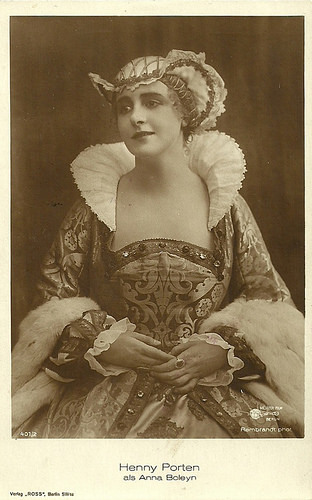
German postcard by Ross Verlag, Berlin, no. 401/2, 1919-1924. Photo: Rembrandt Phot. / Messter Film, Berlin. Publicity still for Anna Boleyn (Ernst Lubitsch, 1920).
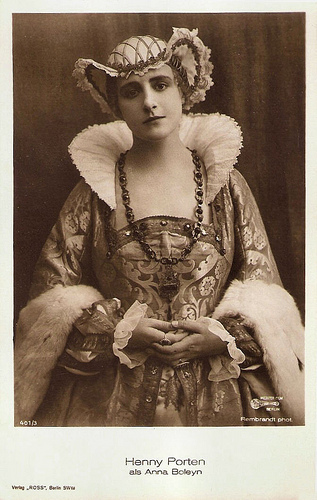
German postcard by Ross Verlag, Berlin, no. 401/3, 1919-1924. Photo: Rembrandt Phot. / Messter Film, Berlin. Publicity still for Anna Boleyn (Ernst Lubitsch, 1920).
Sources: Jason Ankeny (AllMovie), Fernando F. Croce (Slant), Ian Johnston (Not Coming to a Theater Near You), AllMovie, Wikipedia and IMDb.

German postcard by Ross Verlag, Berlin, no. 402/1, 1919-1924. Photo: Rembrandt Phot. / Messter Film, Berlin. Publicity still for Anna Boleyn (Ernst Lubitsch, 1920).

German postcard by Ross Verlag, Berlin, no. 402/2, 1919-1924. Photo: Rembrandt Phot. / Messter Film, Berlin. Publicity still for Anna Boleyn (Ernst Lubitsch, 1920).

German postcard by Ross Verlag, Berlin, no. 402/4, 1919-1924. Photo: Rembrandt Phot. / Messter Film, Berlin. Publicity still for Anna Boleyn (Ernst Lubitsch, 1920) with Henny Porten .
The Bad Tempered King of England
Anne Boleyn was the second wife of King Henry VIII of England. Their marriage led to momentous political and religious turmoil. For Ernst Lubitsch ' film the script was written by Norbert Falk (as Fred Orbing) and Hanns Kräly.
Lubitsch presents Anna ( Henny Porten ) as an innocent, a naïve and guileless young woman who is the newly arrived lady-in-waiting to the Queen. She catches the lustful eye of Henry VIII ( Emil Jannings ), who loves to feast, drink, hunt, and chase around after young beauties. He is tired of Queen to Catherine of Aragon (Hedwig Pauly-Winterstein), and annuls his marriage to her, against the wishes of the pope.
The pompous monarch breaks with Rome, forms the Church of England and marries Anne at the Cathedral. The marriage and the sumptuous festivities that follow are filmed by Lubitsch as spectacular crowd scenes.
Henry tells Anne it is her holy duty to produce a male heir to the throne. But when Anne only gives birth to a baby girl (the later Queen Elizabeth), Henry VIII soon has his eye on yet another lady-in-waiting, Jane Seymour ( Aud Egede Nissen ).
The bad-tempered King charges his wife with adultery and treason, and imprisons her in the Tower of London. Anne is tortured and confesses to infidelity. She is sentenced to death and at in the final scene of the film she is beheaded.

German postcard by Ross Verlag, Berlin, no. 645/1, 1919-1924. Photo: Union. Publicity still for Anna Boleyn (Ernst Lubitsch, 1920) with Henny Porten and Paul Hartmann .

German postcard by Ross Verlag, Berlin, no. 645/3, 1919-1924. Photo: Union Film.

German postcard by Ross Verlag, Berlin, no. 645/4, 1919-1924. Photo: Union Film. The baby represents the future queen Elizabeth I.

German postcard by Ross Verlag, Berlin, no. 645/5, 1919-1924. Photo: Union. Publicity still for Anna Boleyn (Ernst Lubitsch, 1920) with Emil Jannings , Henny Porten and Ludwig Hartau as the Duke of Norfolk.

German postcard by Ross Verlag, Berlin, no. 645/6, 1919-1924. Photo: Union. Publicity still for Anna Boleyn (Ernst Lubitsch, 1920) with Henny Porten and Ludwig Hartau.

German postcard by Ross Verlag, Berlin, no. 645/7, 1919-1924. Photo: Union. Publicity still for Anna Boleyn (Ernst Lubitsch, 1920) with Henny Porten and Paul Hartmann .

German postcard by Ross Verlag, no. 645/8, 1919-1924. Photo: Union. Publicity still for Anna Boleyn (Ernst Lubitsch, 1920) with Henny Porten .
The time is worth spending
In Anne Boleyn, Ernst Lubitsch lets his characters breathe and reveal their corruption down to the tiniest of meannesses. He takes his time, which can try the patience of an audience accustomed to being carried away by action, but the time is worth spending.
A beautiful aspect of Anne Boleyn are the very lavish medieval costuming and the large and elaborate exterior and interior sets. The outdoor scenes are impressive for 1920: a court sports event, Anna’s coronation, a Spring Festival, a hunt, a joust, and even a street battle outside the cathedral.
Emil Jannings is striking and memorable as King Henry the Eighth. He seems to have stepped straight out of Hans Holbein's famous portrait of King Henry VIII.
To introduce the king, Lubitsch uses one of his favourite comedy techniques: the pull-back-and-reveal. A year earlier, he had used this technique in the opening shot of Die Austernprinzessin/The Oyster Princess (1919) to show the bloated Oyster King surrounded by his lackeys. That shot is duplicated here and the look is slightly more realistic but just as revelatory of the character.
Anna Boleyn’s innocence is underlined by Lubitsch through the contrast with the very different character of Jane Seymour ( Aud Egede Nissen ). Jane is in a sense a mirror image in negative of Anna ( Henny Porten ). In the late confrontation between the two Jane claims that she serves Anna, but Lubitsch once again positions Anna as innocent: here, dressed in a simple nightdress, Anna kneels before the haughty Jane in her fine clothes.
Ernst Lubitsch constantly composes shots in depth in Anna Boleyn, looking down corridors or through into larger rooms, from the early moments at the harbour where a set of doors are opened onto a bustling street, to the haunting final view of the scaffold.

German postcard by Ross Verlag, Berlin, no. 472/1, 1919-1924. Photo: Rembrandt Phot. / Union Film with Aud Egede Nissen

Ufa Tempelhof studio, set for Anna Boleyn. Album picture from Vom Werden Deutscher Filmkunst (Oskar Kalbus). Part 1. Silent cinema, Altona-Bahrenfeld (Cigaretten-Bilderdienst) 1935.
Bland characterisation
Most critics on the net have mixed thoughts about the film. Ian Johnston at Not Coming to a Theater Near You : "Anna Boleyn does everything to meet the requirements of the historical epic. (...) But the film suffers from Anna’s bland characterisation and a general plodding, predictable tone. It only really comes alive with the character of King Henry."
Lubitsch' film was not the only art work inspired by the tragic figure of Anna Boleyn. Anna has inspired or been mentioned in numerous paintings, novels and films.
In the cinema, she was first portrayed by Clara Kimball Young in a 1912 short film about Cardinal Wolsey. After the portrayal by Henny Porten followed Merle Oberon in the sound film The Private Life of Henry VIII which won an Oscar for Charles Laughton 's portrayal of Henry. Oberon received an Oscar nomination.
Elaine Stewart played Anne Boleyn in the film Young Bess (1953), starring Jean Simmons . Geneviève Bujold won a Golden Globe Award, and was nominated for an Oscar, for her portrayal of Anne in Anne of the Thousand Days (1969). Dorothy Tutin was nominated for a BAFTA TV Award for her role as Anne in the mini-series The Six Wives of Henry VIII (1970). When that mini-series was compressed into a film, Charlotte Rampling played Anne in the film version entitled Henry VIII and his Six Wives (1972). Finally, Natalie Portman portrayed Anne in the film The Other Boleyn Girl (2008).

German postcard by Ross Verlag, Berlin, no. 401/2, 1919-1924. Photo: Rembrandt Phot. / Messter Film, Berlin. Publicity still for Anna Boleyn (Ernst Lubitsch, 1920).

German postcard by Ross Verlag, Berlin, no. 401/3, 1919-1924. Photo: Rembrandt Phot. / Messter Film, Berlin. Publicity still for Anna Boleyn (Ernst Lubitsch, 1920).
Sources: Jason Ankeny (AllMovie), Fernando F. Croce (Slant), Ian Johnston (Not Coming to a Theater Near You), AllMovie, Wikipedia and IMDb.
Published on June 05, 2015 22:00
June 4, 2015
Luisa Rivelli
Sexy film actress Luisa Rivelli (1930) played many secondary roles in the Italian cinema. She appeared in 50 films between 1943 and 1994 and she was also often seen on Italian television.
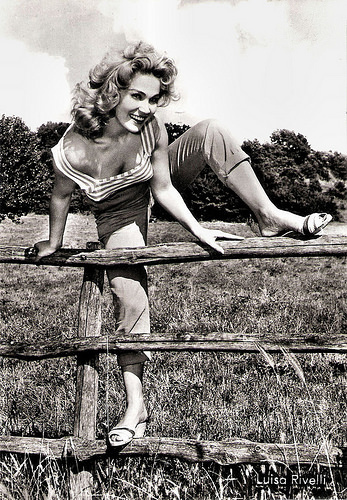
Italian postcard by Bromostampa, Milano, no. 193.
Spaghetti Westerns
Luisa Rivelli was born as Rossella Lanfranchi in Ternate in Lombardy, Italy, in 1930. She studied at the Centro Sperimentale di Cinematografia in Rome.
Rivelli played supporting parts in films like the Italian comedy Non è mai troppo tardi/It's Never Too Late (Filippo Walter Ratti. 1953), based on the novel A Christmas Carol by Charles Dickens, La signora senza camelie/Camille Without Camelias (Michelangelo Antonioni, 1953), and La legge/The Law (Jules Dassin, 1959) starring Gina Lollobrigida .
During the 1960s followed roles in films like the comedy Io, io, io... e gli altri/Me, Me, Me... and the Others (Alessandro Blasetti, 1966) and the Spaghetti Westerns La resa dei conti/The big gundown (Sergio Sollima, 1966) with Lee van Cleef and La belva/Rough Justice (Mario Costa, 1970) starring Klaus Kinski .
In 1968, she presented the popular Sanremo festival, together with Pippo Baudo. From the 1970s on, she became a well known TV personality. She presented programs such as Io compro, tu compri/I buy, you buy (1970-1973), Filo diretto: dalla parte del consumatore (1975-1980), and I problemi del signor Rossi (1981-1985).
Trailer La resa dei conti/The big gundown (Sergio Sollima, 1966). Source: chikungfu (Daily Motion).
Trailer Silenzio: Si uccide/Handle with Care (Guido Zurli, 1967). Source: Italo-Cinema Trailer (YouTube).
Sources: Wikipedia (Italian and English) and .

Italian postcard by Bromostampa, Milano, no. 193.
Spaghetti Westerns
Luisa Rivelli was born as Rossella Lanfranchi in Ternate in Lombardy, Italy, in 1930. She studied at the Centro Sperimentale di Cinematografia in Rome.
Rivelli played supporting parts in films like the Italian comedy Non è mai troppo tardi/It's Never Too Late (Filippo Walter Ratti. 1953), based on the novel A Christmas Carol by Charles Dickens, La signora senza camelie/Camille Without Camelias (Michelangelo Antonioni, 1953), and La legge/The Law (Jules Dassin, 1959) starring Gina Lollobrigida .
During the 1960s followed roles in films like the comedy Io, io, io... e gli altri/Me, Me, Me... and the Others (Alessandro Blasetti, 1966) and the Spaghetti Westerns La resa dei conti/The big gundown (Sergio Sollima, 1966) with Lee van Cleef and La belva/Rough Justice (Mario Costa, 1970) starring Klaus Kinski .
In 1968, she presented the popular Sanremo festival, together with Pippo Baudo. From the 1970s on, she became a well known TV personality. She presented programs such as Io compro, tu compri/I buy, you buy (1970-1973), Filo diretto: dalla parte del consumatore (1975-1980), and I problemi del signor Rossi (1981-1985).
Trailer La resa dei conti/The big gundown (Sergio Sollima, 1966). Source: chikungfu (Daily Motion).
Trailer Silenzio: Si uccide/Handle with Care (Guido Zurli, 1967). Source: Italo-Cinema Trailer (YouTube).
Sources: Wikipedia (Italian and English) and .
Published on June 04, 2015 22:00
June 3, 2015
Napoléon 1er (1909)
On 18 June it will be exactly 200 years since the French emperor Napoléon Bonaparte was finally defeated by the allied British, Prussian, Dutch and Belgian troops near the Belgian village of Waterloo. The battle not only marked the end of Napoleon, but also the beginning of modern Europe. Yesterday, a presentation on 200 years of Waterloo opened in the Rijksmuseum in Amsterdam. The centrepiece of this presentation is the largest painting (5.67 x 8.23 meters) of the Rijksmuseum, The Battle of Waterloo by Jan Willem Pieneman from 1824. At La Collectionneuse, Marlène Pilaete made a beautiful gallery post 'Napoléon et ces dames', with postcards and bios of 14 actresses who portrayed the women around Napoléon in films. At Flickr, we posted a series of Belgian postcards on the Waterloo Panorama near Brussels, painted 1911, so almost a century after the famous Battle of Waterloo (1815). And this post at EFSP is about the silent Pathé Frères film Napoléon 1er, aka Napoléon (1909).
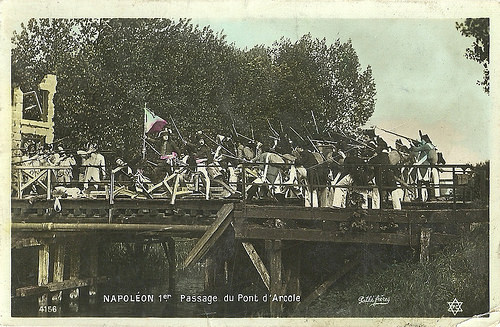
French postcard by PC, no. 4156. Photo: Pathé Frères. Publicity still for Napoléon 1er/Napoléon (1909). Caption: Passage de Pont d'Arcole (Passing the Bridge of Arcole). This postcard seems to have been inspired by Horace Vernet's 1826 painting Bataille du Pont d'Arcole, now at Christie's, London.
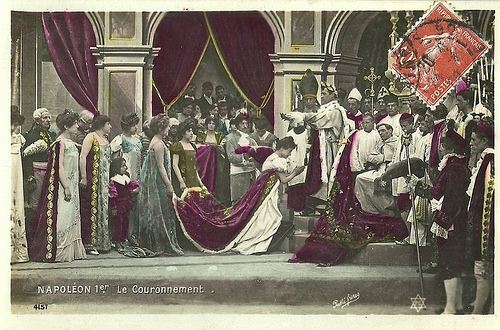
French postcard by PC, no. 4157. Photo: Pathé Frères. Publicity still for Napoléon 1er/Napoléon (1909). Caption: Le Couronnement (The Coronation). This postcard is a reduced, tableau vivant-like citation of Jacques-Louis David's famous painting The Consecration of the Emperor Napoléon I and Coronation of the Empress Josephine (1805-1807) now at the Louvre, Paris.
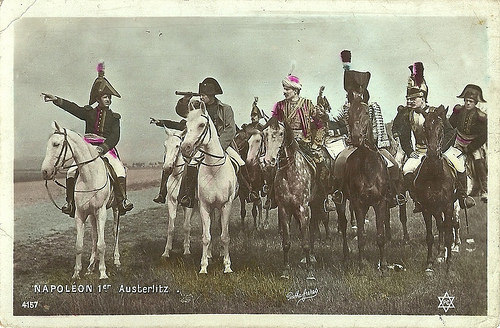
French postcard by PC, no. 4157. Photo: Pathé Frères. Publicity still for Napoléon 1er/Napoléon (1909). Caption: Austerlitz.
Unknown director
The short silent film Napoléon 1er/Napoléon (1909) was made in two parts. Napoleon Bonaparte was played by Maximilien Charlier, the director of the film is unknown. The film was released by Pathé in May 1909.
Almost all the cards (the series is alas incomplete) refer to the first part:
1- Siège de Toulon (novembre 1793)
2- Arcole (novembre 1796)
3- Campagne d’Égypte (juillet 1798)
4- Passage du Saint Bernard (novembre 1799)
5- La Malmaison (juin 1800)
6- Le Couronnement (décembre 1804)
7- Austerlitz (décembre 1805)
8- Ratisbonne (avril 1809)
9- Présentation du Roi de Rome (mars 1811).
The second part of the film consists of:
1- Incendie de Moscou (septembre 1812)
2- Napoléon et le Pape (janvier 1813)
3- L’abdication et les adieux de Fontainebleau (avril 1814)
4- Waterloo (juin 1815)
5- Captivité et mort le 5 mai 1821
An additional card which is not mentioned at the site of the Pathé archives, shows the snowball fight at the Ecole de Brienne.
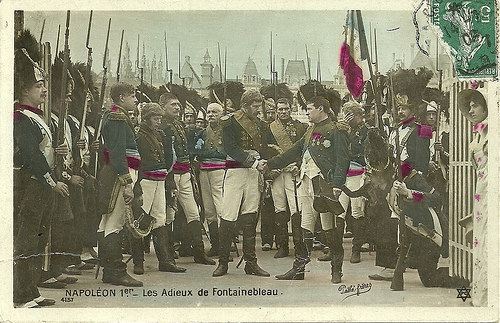
French postcard by PC, no. 4157. Photo: Pathé Frères. Publicity still for Napoléon 1er/Napoléon (1909). Caption: Les adieux de Fontainebleau. This postcard is vaguely inspired by Horace Vernet's Napoléon Leaves the Guard, 1814 (1825).
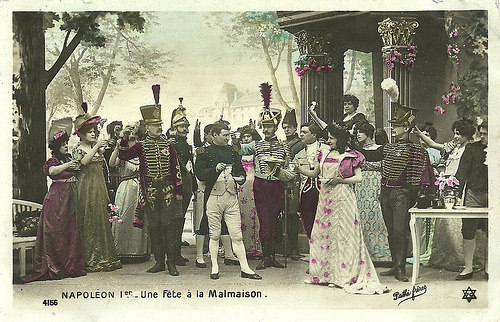
French postcard by PC, no. 4156. Photo: Pathé Frères. Publicity still for Napoléon 1er/Napoléon (1909). Caption: Une fête à Malmaison (Feast at Malmaison). The Chateau de Malmaison in the background seems to have been taken from a painting by François Flameng, Reception at Malmaison in 1802 (1894).
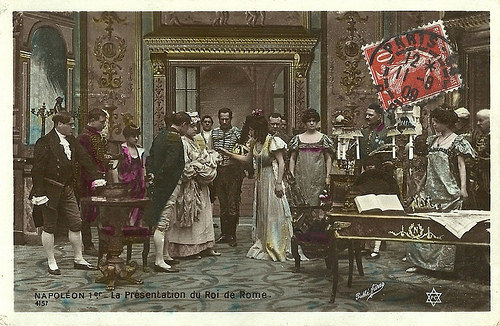
French postcard by PC, no. 4157. Photo: Pathé Frères. Publicity still for Napoléon 1er/Napoléon (1909). Caption: La présentation du Roi de Rome.
A black and white version of the film. Source: The Great Classics (YouTube).
Sources: Fondation Jerome Seydoux (French), Rijksmuseum, Flickr, La Collectionneuse (French) and IMDb.
NB. It is possible that both the postcards and the film on YouTube are actually about the Napoléon film Épopée Napoléonienne (1903) by Lucien Nonguet, also produced by Pathé Frères. We're checking it with the Pathé archives.

French postcard by PC, no. 4156. Photo: Pathé Frères. Publicity still for Napoléon 1er/Napoléon (1909). Caption: Passage de Pont d'Arcole (Passing the Bridge of Arcole). This postcard seems to have been inspired by Horace Vernet's 1826 painting Bataille du Pont d'Arcole, now at Christie's, London.

French postcard by PC, no. 4157. Photo: Pathé Frères. Publicity still for Napoléon 1er/Napoléon (1909). Caption: Le Couronnement (The Coronation). This postcard is a reduced, tableau vivant-like citation of Jacques-Louis David's famous painting The Consecration of the Emperor Napoléon I and Coronation of the Empress Josephine (1805-1807) now at the Louvre, Paris.

French postcard by PC, no. 4157. Photo: Pathé Frères. Publicity still for Napoléon 1er/Napoléon (1909). Caption: Austerlitz.
Unknown director
The short silent film Napoléon 1er/Napoléon (1909) was made in two parts. Napoleon Bonaparte was played by Maximilien Charlier, the director of the film is unknown. The film was released by Pathé in May 1909.
Almost all the cards (the series is alas incomplete) refer to the first part:
1- Siège de Toulon (novembre 1793)
2- Arcole (novembre 1796)
3- Campagne d’Égypte (juillet 1798)
4- Passage du Saint Bernard (novembre 1799)
5- La Malmaison (juin 1800)
6- Le Couronnement (décembre 1804)
7- Austerlitz (décembre 1805)
8- Ratisbonne (avril 1809)
9- Présentation du Roi de Rome (mars 1811).
The second part of the film consists of:
1- Incendie de Moscou (septembre 1812)
2- Napoléon et le Pape (janvier 1813)
3- L’abdication et les adieux de Fontainebleau (avril 1814)
4- Waterloo (juin 1815)
5- Captivité et mort le 5 mai 1821
An additional card which is not mentioned at the site of the Pathé archives, shows the snowball fight at the Ecole de Brienne.

French postcard by PC, no. 4157. Photo: Pathé Frères. Publicity still for Napoléon 1er/Napoléon (1909). Caption: Les adieux de Fontainebleau. This postcard is vaguely inspired by Horace Vernet's Napoléon Leaves the Guard, 1814 (1825).

French postcard by PC, no. 4156. Photo: Pathé Frères. Publicity still for Napoléon 1er/Napoléon (1909). Caption: Une fête à Malmaison (Feast at Malmaison). The Chateau de Malmaison in the background seems to have been taken from a painting by François Flameng, Reception at Malmaison in 1802 (1894).

French postcard by PC, no. 4157. Photo: Pathé Frères. Publicity still for Napoléon 1er/Napoléon (1909). Caption: La présentation du Roi de Rome.
A black and white version of the film. Source: The Great Classics (YouTube).
Sources: Fondation Jerome Seydoux (French), Rijksmuseum, Flickr, La Collectionneuse (French) and IMDb.
NB. It is possible that both the postcards and the film on YouTube are actually about the Napoléon film Épopée Napoléonienne (1903) by Lucien Nonguet, also produced by Pathé Frères. We're checking it with the Pathé archives.
Published on June 03, 2015 22:00
June 2, 2015
Imported from the USA: Barbara Payton
We continue our weekly series 'Imported from the USA' of posts about Hollywood stars who also worked in the European cinema. Today the very sad tale of blue-eyed, peroxide blonde sexpot Barbara Payton (1927-1967). She was less known for her films than for her stormy social life and eventual battles with alcohol and drug addiction. At the end of her film career, she made two interesting films in Great Britain.
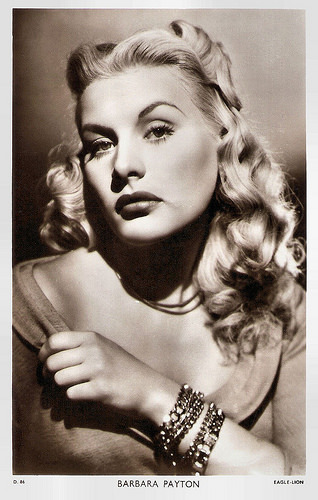
British postcard in the Picturegoer Series, London, no. D 86. Photo: Eagle-Lion.
Blossoming good looks
Barbara Payton was born Barbara Lee Redfield in Cloquet, Minnesota, in 1927. She was the daughter of Norwegian immigrants Erwin Lee Redfield and Mabel Irene Todahl. A son, Frank Leslie III was born in 1931. In 1938, the family moved to Odessa, Texas, where Payton’s father started a motel court. Both of Payton's parents had long-standing problems with alcohol.
As Payton was growing into maturity her good looks were also blossoming which garnered her attention. She was known as a lively girl, willing to please and she learned early in life that she had a potent effect on the opposite sex. In November 1943, the then sixteen-year-old eloped with her high school boyfriend William Hodge. The marriage seemingly amounted to nothing more than an act of impulsive, teen-age rebellion, and Payton did not fight her parent's insistence that the marriage be annulled. A few months later, she quit high school.
In 1944, she met her second husband, a decorated combat pilot named John Payton, who at the time was stationed at Midland Air Base. The handsome couple were married in 1945 and moved to Los Angeles where John enrolled at USC under the G.I. Bill. It was still early in their marriage that Barbara, restless and feeling confined by her life as a housewife, expressed a desire to pursue a modelling or acting career. Payton officially launched her modelling path by hiring the services of a local photographer who shot photos of her sporting fashionable outfits. This portfolio attracted the favourable attention of a clothing designer, Saba of California, who signed her to a contract modelling a line of junior fashion.
Her career progressed and in September 1947, the Rita La Roy Agency in Hollywood took her on as a client and brought her more work as a model in print advertising; notably in catalogues for Studebaker cars. She also appeared in clothing ads for such magazines as Charm and Junior Bazaar. During this period in her life, the couple welcomed their son, John Lee, who was born in February 1947. Payton managed to combine the responsibilities of wife, new mother and professional model, yet the strains on the Payton marriage finally reached the breaking point and Barbara and her husband separated in 1948.
Barbara took an apartment in Hollywood with her infant son, with whom she was very close. Payton's drive, fuelled by her high-energy personality, had become focused on promoting her career and showcasing her beauty around the town’s hot spots. She was labelled the 'Queen of the Night Clubs' by columnist Harrison Carroll. Her notoriety as a luminous, fun loving party girl in the Hollywood club scene ignited the attention of William Goetz, an executive of Universal Studios. In January 1949, he signed her, aged twenty-one, to a contract with a starting salary of $100 per week.
Payton first gained notice as a drop-dead gorgeous young woman in the film noir Trapped (Richard Fleischer, 1949), co-starring Lloyd Bridges. In 1950, she was given the opportunity to make a screen test for John Huston's production of the forthcoming MGM crime drama The Asphalt Jungle. She was not chosen and the part of the sultry mistress of a mob connected lawyer went to Marilyn Monroe.
After being screen-tested by James Cagney and his producer brother William, Payton starred with Cagney in the violent noir thriller Kiss Tomorrow Goodbye (Gordon Douglas, 1950). William Cagney was so smitten with Payton's sensual appeal and beauty that her contract was drawn as a joint agreement between William Cagney Productions and Warner Bros. who together saw fit to bestow on Payton a salary of $5,000 a week; a large sum for an actress yet to demonstrate star power at the box-office.
For a relative newcomer, Payton more than managed to hold her own in Kiss Tomorrow Goodbye among a cast of Hollywood veterans and alongside a super-star like Cagney himself. Her portrayal of the hardened, seductive girlfriend, whom Cagney’s character ultimately double-crosses, was critically praised in newspaper reviews of the film. Her acting skills were recognized and her significant screen charisma widely acknowledged. Kiss Tomorrow Goodbye was the highpoint in Payton’s career, the moment in time she was christened as a player with bonafide star power.

British postcard in The People series by Show Parade Picture Service, London, no. P. 1033. Photo: Universal-International.
A black eye and a tarnished reputation
Caught up in the glitz and glamour, Barbara Payton's career had started taking second place to a reckless life full of capricious romances involving a number of top stars and producers, many of them married. In 1949, she had a six month affair with Bob Hope in which he paid for her to live in a luxurious apartment. The affair ended when she began making demands for more money.
Her screen appearances opposite Gary Cooper in Dallas (Stuart Heisler, 1950), and Gregory Peck in Only the Valiant (Gordon Douglas, 1951), both Westerns, were lacklustre productions where her roles were no more than window dressing for the hero and did little to highlight her skills as an actress.
Payton's career decline began with the horror film Bride of the Gorilla (Curt Siodmak, 1951), co-starring Raymond Burr. However, her slightly lurid appeal still seemed to be enough to carry her through Tinseltown. According to rumours, she had affairs with producer Howard Hughes, Woody Strode, George Raft, Dallas co-stars Gary Cooper and Steve Cochran, John Ireland, and Texas oilman Bob Neal.
In addition to her first two marriages, Payton was married two more times. In 1950, she had met classy 'A' actor Franchot Tone and the two were later engaged. She was the subject of a spread in Confidential Magazine when Tone allegedly caught her in bed with Guy Madison. In 1951, while engaged to Tone, Payton began also having an affair with muscular B-movie actor Tom Neal, and she also proposed marriage to him. She allowed him to move into her apartment, which Tone was paying the rent for. She kicked him out when Tone returned from out of town.
Payton went back and forth publicly between Neal and Tone. On 14 September 1951, Tom Neal, a former college boxer, physically attacked Tone at Payton's apartment leaving him in an 18-hour coma with a smashed cheekbone, broken nose and concussion. Barbara ended up with both a black eye and a tarnished reputation. Payton and Tone, who was still recovering from his injuries, were married in 1951 in Payton's hometown of Cloquet, Minnesota. However, after being married, Tone discovered that she had continued her relations with the violence-prone Neal and Tone was subsequently granted a divorce in 1952. When Franchot Tone decided to divorce her, he had a private detective take pictures of her having sex with other men. He then sent the photos to all the major Hollywood studios, hoping they would ruin her career. They did.
Payton and Neal capitalized on the notorious press coverage by touring in plays such as The Postman Always Rings Twice, based on the popular 1946 film of the same name. They would also star together in The Great Jesse James Raid (Reginald Le Borg, 1953), a B-Western that received a limited released to theatres. In May 1953, Payton announced that she and Neal were to be married that summer in Paris. The couple broke up the following year.
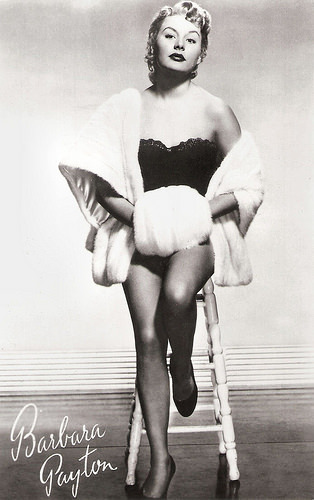
Dutch postcard by DRC, no. F 154. Photo: Warner Bros.
I am not ashamed
Barbara Payton's hard drinking and hard living ultimately destroyed her both physically and emotionally. Gary Brumburgh at IMDb : "She went to England to try to rejuvenate her career, but no dice; it was over and her life was skidding out of control. Her once beautiful face now blotchy and her once spectacular figure now bloated, Barbara sank deeper into the bottle."
In England, she starred for the Hammer studio in the Science Fiction film Four Sided Triangle/The Monster and the Woman (Terence Fisher, 1953). And although Leonard Maltin called it a 'bomb' in his Movie Guide , among Hammer fans at IMDb both the film and Payton's acting are highly regarded.
Reportedly, she was also good in her last leading role in the Film Noir Murder Is My Beat (Edgar G. Ullmer, 1955). Linda Rasmussen at AllMovie : "Director Edgar G. Ulmer uses flashbacks and elliptical editing to good effect, but the film lacks any strong visual or narrative center. Barbara Peyton delivers a great performance as the ambiguous, mysterious femme-fatale. While still of some interest, Murder is My Beat lacks the power and grim vision of Ulmer's bleak gem, Detour."
In 1955, Payton married George A. 'Tony' Provas, a furniture store executive in Nogales, Arizona. They divorced in August 1958. In March 1956 she lost custody of her son John Lee Jr. after her ex-husband charged that she exposed their son to "profane language, immoral conduct, notoriety, unwholesome activities" and failed to provide the boy with a "moral education". From then on, her growing alcoholism and drug abuse led to multiple skirmishes with the law, including an arrest for the passing of bad checks.
In 1962, Payton was arrested for prostitution when she propositioned an undercover cop in a Sunset Boulevard bar. Later that year, she was stabbed by a drunk and received 38 stitches to heal the wound. In 1963, she published her autobiography, I Am Not Ashamed, which was ghost written by Leo Guild. She didn't want to be paid in cash or check, but asked for payment in red wine because there were claims on her cash. The book included unflattering photographs of Payton and admissions that she had been forced to sleep on bus benches and suffered regular beatings as a prostitute. In 1965, she was arrested and charged with possession of heroin and a hypodermic syringe.
In 1967, ill and after failed efforts to curb her drinking, Barbara Payton moved back to San Diego, California, to live with her parents. Several weeks later, the 39-year-old former starlet was found there on the bathroom floor - dead of heart and liver failure. Her son, John Lee Payton Jr., was serving in Vietnam when she died. Her life has been the subject of several books including Kiss Tomorrow Goodbye: The Barbara Payton Story (2007), by John O'Dowd, L.A. Despair: A Landscape of Crimes and Bad Times (2005), by John Gilmore, and B Movie. a Play in Two Acts (2014), by Michael B. Druxman.
Trailer Kiss Tomorrow Goodbye (Gordon Douglas, 1950). Source: Felixxxx9999 (YouTube).
Trailer for Bride of the Gorilla (Curt Siodmak, 1951). Source: Trailers, Sci, and/or Fi (YouTube).
Trailer for the British Film Noir The Flanagan Boy/Bad Blonde (Reginald LeBorg, 1953). Source: Captain Bijou (YouTube).
Sources: (IMDb), Linda Rasmussen (AllMovie), Wikipedia and .

British postcard in the Picturegoer Series, London, no. D 86. Photo: Eagle-Lion.
Blossoming good looks
Barbara Payton was born Barbara Lee Redfield in Cloquet, Minnesota, in 1927. She was the daughter of Norwegian immigrants Erwin Lee Redfield and Mabel Irene Todahl. A son, Frank Leslie III was born in 1931. In 1938, the family moved to Odessa, Texas, where Payton’s father started a motel court. Both of Payton's parents had long-standing problems with alcohol.
As Payton was growing into maturity her good looks were also blossoming which garnered her attention. She was known as a lively girl, willing to please and she learned early in life that she had a potent effect on the opposite sex. In November 1943, the then sixteen-year-old eloped with her high school boyfriend William Hodge. The marriage seemingly amounted to nothing more than an act of impulsive, teen-age rebellion, and Payton did not fight her parent's insistence that the marriage be annulled. A few months later, she quit high school.
In 1944, she met her second husband, a decorated combat pilot named John Payton, who at the time was stationed at Midland Air Base. The handsome couple were married in 1945 and moved to Los Angeles where John enrolled at USC under the G.I. Bill. It was still early in their marriage that Barbara, restless and feeling confined by her life as a housewife, expressed a desire to pursue a modelling or acting career. Payton officially launched her modelling path by hiring the services of a local photographer who shot photos of her sporting fashionable outfits. This portfolio attracted the favourable attention of a clothing designer, Saba of California, who signed her to a contract modelling a line of junior fashion.
Her career progressed and in September 1947, the Rita La Roy Agency in Hollywood took her on as a client and brought her more work as a model in print advertising; notably in catalogues for Studebaker cars. She also appeared in clothing ads for such magazines as Charm and Junior Bazaar. During this period in her life, the couple welcomed their son, John Lee, who was born in February 1947. Payton managed to combine the responsibilities of wife, new mother and professional model, yet the strains on the Payton marriage finally reached the breaking point and Barbara and her husband separated in 1948.
Barbara took an apartment in Hollywood with her infant son, with whom she was very close. Payton's drive, fuelled by her high-energy personality, had become focused on promoting her career and showcasing her beauty around the town’s hot spots. She was labelled the 'Queen of the Night Clubs' by columnist Harrison Carroll. Her notoriety as a luminous, fun loving party girl in the Hollywood club scene ignited the attention of William Goetz, an executive of Universal Studios. In January 1949, he signed her, aged twenty-one, to a contract with a starting salary of $100 per week.
Payton first gained notice as a drop-dead gorgeous young woman in the film noir Trapped (Richard Fleischer, 1949), co-starring Lloyd Bridges. In 1950, she was given the opportunity to make a screen test for John Huston's production of the forthcoming MGM crime drama The Asphalt Jungle. She was not chosen and the part of the sultry mistress of a mob connected lawyer went to Marilyn Monroe.
After being screen-tested by James Cagney and his producer brother William, Payton starred with Cagney in the violent noir thriller Kiss Tomorrow Goodbye (Gordon Douglas, 1950). William Cagney was so smitten with Payton's sensual appeal and beauty that her contract was drawn as a joint agreement between William Cagney Productions and Warner Bros. who together saw fit to bestow on Payton a salary of $5,000 a week; a large sum for an actress yet to demonstrate star power at the box-office.
For a relative newcomer, Payton more than managed to hold her own in Kiss Tomorrow Goodbye among a cast of Hollywood veterans and alongside a super-star like Cagney himself. Her portrayal of the hardened, seductive girlfriend, whom Cagney’s character ultimately double-crosses, was critically praised in newspaper reviews of the film. Her acting skills were recognized and her significant screen charisma widely acknowledged. Kiss Tomorrow Goodbye was the highpoint in Payton’s career, the moment in time she was christened as a player with bonafide star power.

British postcard in The People series by Show Parade Picture Service, London, no. P. 1033. Photo: Universal-International.
A black eye and a tarnished reputation
Caught up in the glitz and glamour, Barbara Payton's career had started taking second place to a reckless life full of capricious romances involving a number of top stars and producers, many of them married. In 1949, she had a six month affair with Bob Hope in which he paid for her to live in a luxurious apartment. The affair ended when she began making demands for more money.
Her screen appearances opposite Gary Cooper in Dallas (Stuart Heisler, 1950), and Gregory Peck in Only the Valiant (Gordon Douglas, 1951), both Westerns, were lacklustre productions where her roles were no more than window dressing for the hero and did little to highlight her skills as an actress.
Payton's career decline began with the horror film Bride of the Gorilla (Curt Siodmak, 1951), co-starring Raymond Burr. However, her slightly lurid appeal still seemed to be enough to carry her through Tinseltown. According to rumours, she had affairs with producer Howard Hughes, Woody Strode, George Raft, Dallas co-stars Gary Cooper and Steve Cochran, John Ireland, and Texas oilman Bob Neal.
In addition to her first two marriages, Payton was married two more times. In 1950, she had met classy 'A' actor Franchot Tone and the two were later engaged. She was the subject of a spread in Confidential Magazine when Tone allegedly caught her in bed with Guy Madison. In 1951, while engaged to Tone, Payton began also having an affair with muscular B-movie actor Tom Neal, and she also proposed marriage to him. She allowed him to move into her apartment, which Tone was paying the rent for. She kicked him out when Tone returned from out of town.
Payton went back and forth publicly between Neal and Tone. On 14 September 1951, Tom Neal, a former college boxer, physically attacked Tone at Payton's apartment leaving him in an 18-hour coma with a smashed cheekbone, broken nose and concussion. Barbara ended up with both a black eye and a tarnished reputation. Payton and Tone, who was still recovering from his injuries, were married in 1951 in Payton's hometown of Cloquet, Minnesota. However, after being married, Tone discovered that she had continued her relations with the violence-prone Neal and Tone was subsequently granted a divorce in 1952. When Franchot Tone decided to divorce her, he had a private detective take pictures of her having sex with other men. He then sent the photos to all the major Hollywood studios, hoping they would ruin her career. They did.
Payton and Neal capitalized on the notorious press coverage by touring in plays such as The Postman Always Rings Twice, based on the popular 1946 film of the same name. They would also star together in The Great Jesse James Raid (Reginald Le Borg, 1953), a B-Western that received a limited released to theatres. In May 1953, Payton announced that she and Neal were to be married that summer in Paris. The couple broke up the following year.

Dutch postcard by DRC, no. F 154. Photo: Warner Bros.
I am not ashamed
Barbara Payton's hard drinking and hard living ultimately destroyed her both physically and emotionally. Gary Brumburgh at IMDb : "She went to England to try to rejuvenate her career, but no dice; it was over and her life was skidding out of control. Her once beautiful face now blotchy and her once spectacular figure now bloated, Barbara sank deeper into the bottle."
In England, she starred for the Hammer studio in the Science Fiction film Four Sided Triangle/The Monster and the Woman (Terence Fisher, 1953). And although Leonard Maltin called it a 'bomb' in his Movie Guide , among Hammer fans at IMDb both the film and Payton's acting are highly regarded.
Reportedly, she was also good in her last leading role in the Film Noir Murder Is My Beat (Edgar G. Ullmer, 1955). Linda Rasmussen at AllMovie : "Director Edgar G. Ulmer uses flashbacks and elliptical editing to good effect, but the film lacks any strong visual or narrative center. Barbara Peyton delivers a great performance as the ambiguous, mysterious femme-fatale. While still of some interest, Murder is My Beat lacks the power and grim vision of Ulmer's bleak gem, Detour."
In 1955, Payton married George A. 'Tony' Provas, a furniture store executive in Nogales, Arizona. They divorced in August 1958. In March 1956 she lost custody of her son John Lee Jr. after her ex-husband charged that she exposed their son to "profane language, immoral conduct, notoriety, unwholesome activities" and failed to provide the boy with a "moral education". From then on, her growing alcoholism and drug abuse led to multiple skirmishes with the law, including an arrest for the passing of bad checks.
In 1962, Payton was arrested for prostitution when she propositioned an undercover cop in a Sunset Boulevard bar. Later that year, she was stabbed by a drunk and received 38 stitches to heal the wound. In 1963, she published her autobiography, I Am Not Ashamed, which was ghost written by Leo Guild. She didn't want to be paid in cash or check, but asked for payment in red wine because there were claims on her cash. The book included unflattering photographs of Payton and admissions that she had been forced to sleep on bus benches and suffered regular beatings as a prostitute. In 1965, she was arrested and charged with possession of heroin and a hypodermic syringe.
In 1967, ill and after failed efforts to curb her drinking, Barbara Payton moved back to San Diego, California, to live with her parents. Several weeks later, the 39-year-old former starlet was found there on the bathroom floor - dead of heart and liver failure. Her son, John Lee Payton Jr., was serving in Vietnam when she died. Her life has been the subject of several books including Kiss Tomorrow Goodbye: The Barbara Payton Story (2007), by John O'Dowd, L.A. Despair: A Landscape of Crimes and Bad Times (2005), by John Gilmore, and B Movie. a Play in Two Acts (2014), by Michael B. Druxman.
Trailer Kiss Tomorrow Goodbye (Gordon Douglas, 1950). Source: Felixxxx9999 (YouTube).
Trailer for Bride of the Gorilla (Curt Siodmak, 1951). Source: Trailers, Sci, and/or Fi (YouTube).
Trailer for the British Film Noir The Flanagan Boy/Bad Blonde (Reginald LeBorg, 1953). Source: Captain Bijou (YouTube).
Sources: (IMDb), Linda Rasmussen (AllMovie), Wikipedia and .
Published on June 02, 2015 22:00
June 1, 2015
Dorothea Wieck
Swiss actress Dorothea Wieck (1908-1986) became a major star and a lesbian idol with her role as the adored teacher Fräulein von Bernburg in the German classic Mädchen in Uniform/Girls in Uniform (1931). She made more than fifty films, but she was also a prominent stage actress of the Deutsche Theater, the Schillertheater and other main theatres in Berlin.
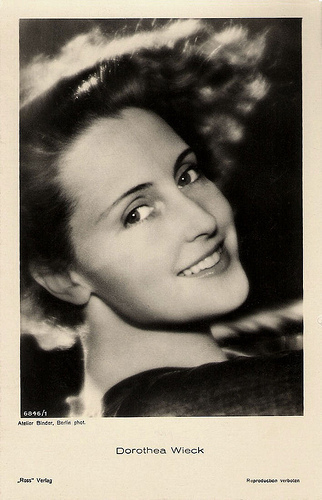
German postcard by Ross Verlag, Berlin, no. 6846/1, 1931-1932. Photo: Atelier Binder, Berlin.
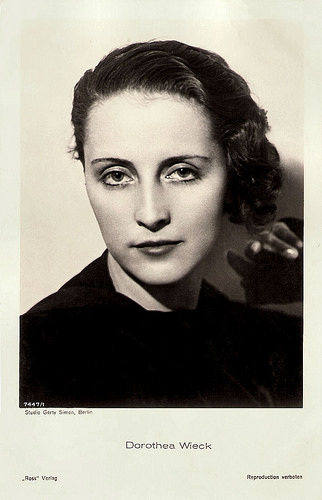
German postcard by Ross Verlag, Berlin, no. 7447, 1932-1933. Photo: Gerty Simon, Berlin.
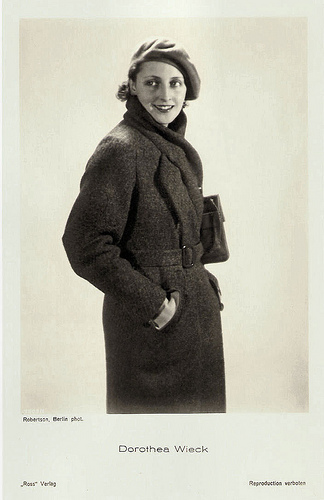
German postcard by Ross Verlag, Berlin, no. 7503/1, 1932-1933. Photo: Robertson, Berlin.
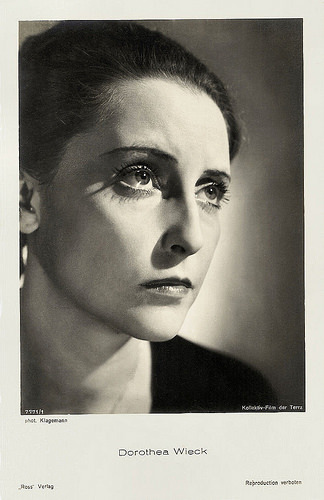
German postcard by Ross Verlag, Berlin, no. 7771/1, 1932-1933. Photo: Klagemann / Terra.
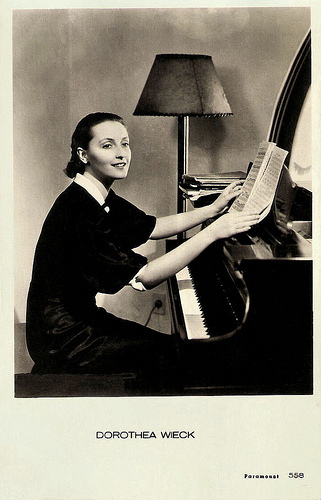
Dutch postcard, no. 558. Sent by mail in 1934. Photo: Paramount.
Silent Films
Dorothea Olavia Wieck was born in Davos, Switzerland, in 1908. She was the daughter of wholesale merchant Hans Leopold Wieck and Friederike Wernicke. After spending most of her childhood in Sweden, Dorothea was schooled in Dresden. At the age of 12, she started to study dance and at 15, she attended acting courses by Maria Moissi, the first wife of Alexander Moissi, in Berlin.
She studied with Max Reinhardt and made her stage debut in Vienna at the Theater in der Josephstadt. Later she appeared in Munich at the Münchner Kammerspiele in plays by Carl Zuckmayer and Ferenc Molnár.
After being spotted by director Franz Seitz, she began her film career with a part in the comedy Heimliche Sünder/Secret Sinners (Franz Seitz, 1926), followed by a bigger role in Die kleine Inge und ihre drei Väter/Little Inge and Her Three Fathers (Franz Osten, 1926).
Soon followed more leading roles in silent films like Ich hab mein Herz in Heidelberg verloren/I Lost My Heart at Heidelberg (Arthur Bergen, 1926), Sturmflut/Storm Tide (Willy Reiber, 1927), and Der Fremdenlegionär/Foreign Legionaire (James Bauer, 1928) with Therese Giehse.
Her breakthrough followed after the introduction of sound film. She had an international success with the pioneering feminist film Mädchen in Uniform/Girls in Uniform (Leontine Sagan, Carl Froelich, 1931). Hertha Thiele co-starred as a sensitive girl, who is sent to an all-girls boarding school where she develops a romantic attachment to one of her teachers, Fräulein von Bernburg (Wieck).
First when the lesbian themed film was released in the United States it was banned. First Lady Eleanor Roosevelt saw the importance of the film though and the ban was lifted. Later in Germany the Nazi regime even tried to burn all the copies of the film, but they couldn't.
Bruce Eder at AllMovie : "it was attacked in its time, though not for the lesbian-oriented, homo-erotic aspects of its story and visuals, but for being a critique of the educational establishment. It thus became an underground classic, taken to heart by iconoclasts of all stripes and, most especially, by lesbian audiences. Even by the standards of the twenty-first century, the honesty of the movie is startling when one considers its origins. The technical side of the filmmaking may be a little frayed, but the acting and direction have endured in their appeal across many decades, and the movie continues to attract attention as something more than an artifact."
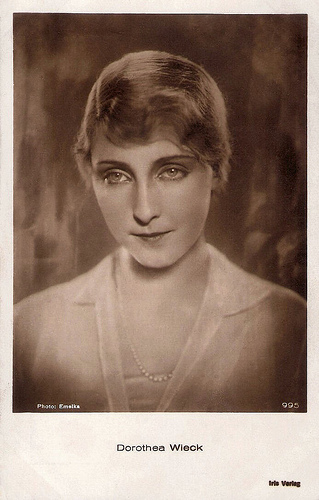
Austrian postcard by Iris Verlag, no. 995. Photo: Emelka.
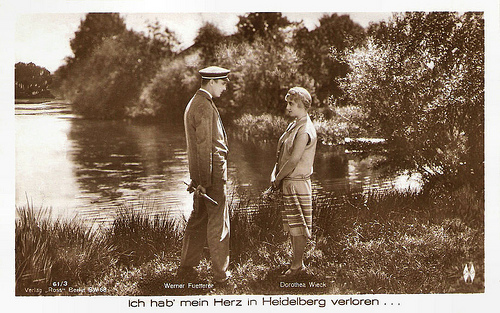
German postcard by Ross Verlag, Berlin, no. 61/3, 1926. Photo: Münchner Lichtspielkunst AG (Emelka). Publicity still for Ich hab mein Herz in Heidelberg verloren/I Lost My Heart in Heidelberg (Arthur Bergen, 1926) with Werner Fuetterer .
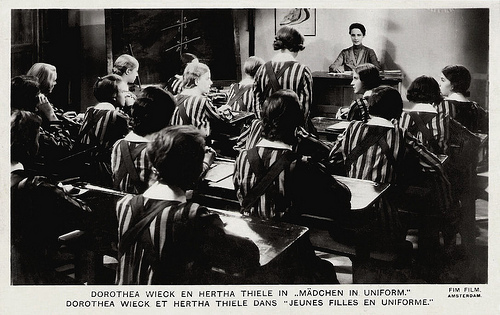
Dutch Postcard by M. Bonnist & Zonen, Amsterdam, Z., no. 104 e. Photo: Fim Film, Amsterdam. Publicity still for Mädchen in Uniform/Girls in Uniform (Leontine Sagan, Carl Froelich, 1931).
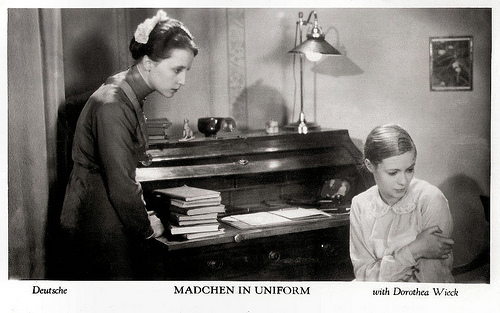
British card in the series Film Shots by Film Weekly. Photo: Deutsche. Publicity still for Mädchen in Uniform/Girls in Uniform (Leontine Sagan, Carl Froelich, 1931) with Hertha Thiele .
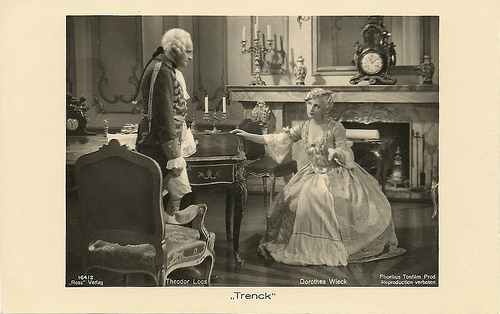
German postcard by Ross Verlag, no. 164/2. Photo: Phoebus Tonfilm prod. Publicity still for Trenck (Ernst Neubach, Heinz Paul, 1932) with Theodoor Loos . Collection: Didier Hanson.
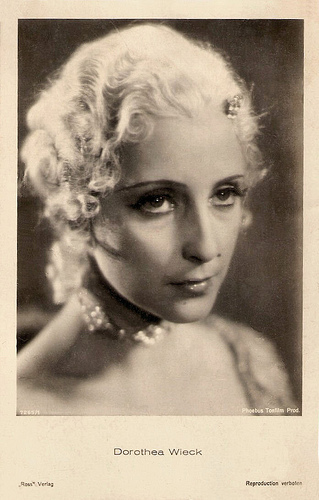
German postcard by Ross Verlag, no. 7265/1, 1932-1933. Photo: Phoebus Tonfilm Prod. Publicity still for Trenck - Der Roman einer großen Liebe/Trenck - The novel of a great love (Ernst Neubach, Heinz Paul, 1932).
Hollywood
In the years after Mädchen in Uniform, Dorothea Wieck starred in well-known productions like the operetta Gräfin Mariza/Countess Mariza (Richard Oswald, 1932), and Anna und Elisabeth (Frank Wisbar, 1933) again with Hertha Thiele .
In 1932, Wieck married baron Ernst von der Decken, a journalist and author. They were not often together and divorced in 1935.
The international success of Mädchen in Uniform led her to Hollywood where she starred in two films, Cradle Song (Mitchell Leisen, 1933) and Miss Fane's Baby Is Stolen (Alexander Hall, 1934), based on the Lindbergh kidnapping case. Both films flopped at the box office and this, combined with accusations of espionage for the Nazis, forced her return to Germany.
In the following years Wieck played in such popular films as Der Student von Prag/The Student of Prague (Arthur Robison, 1935) starring Adolf Wohlbrück (Anton Walbrook), and Die gelbe Flagge/The Yellow Flagg (Gerhard Lamprecht, 1937) with Hans Albers .
During wartime Dorothea Wieck turned her attention to the theatre, and also worked as a stage director. As a celebrated actress, she was repeatedly dinner partner of Chancellor Hitler. She occasionally appeared in front of the camera in the propaganda film Kopf hoch, Johannes!/Head up, Johannes! (Viktor de Kowa, 1941), Andreas Schlüter (Herbert Maisch, 1942) featuring Heinrich George , and Der Grüne Salon/The Green Room (Boleslaw Barlog, 1944). In Italy, she made Inviati speciali/Special Guests (Romolo Marcellini, 1943).
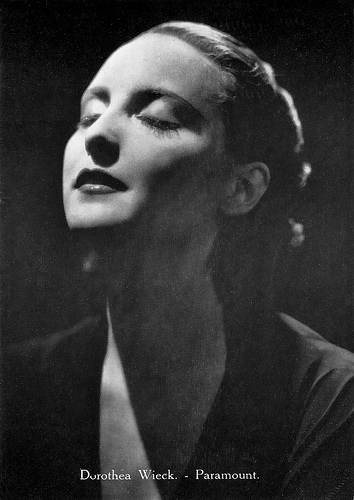
Dutch postcard, printed by Smeets & Schippers, Amsterdam. Photo: Paramount.
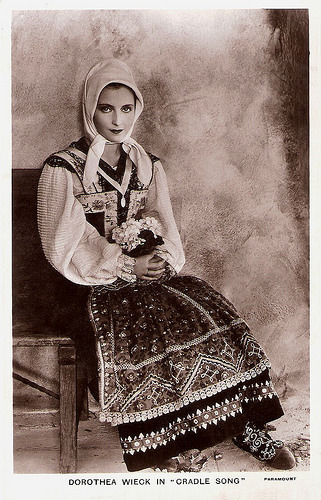
Dutch postcard by M. Bonnist & Zonen, Amsterdam-Z., no. B 299. Photo: Paramount. Publicity still for Cradle Song (Mitchell Leisen, 1933).
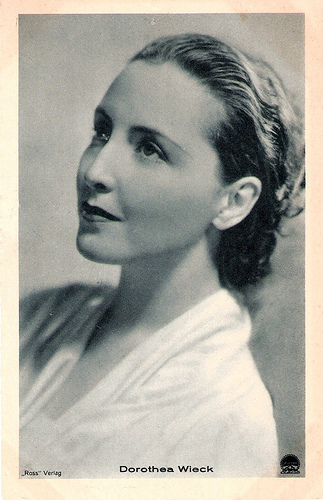
German postcard by Ross Verlag. Photo: Paramount.
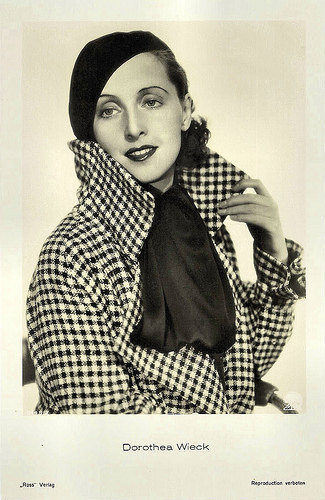
German postcard by Ross Verlag, Berlin, no. 8448/2, 1933-1934. Photo: Paramount.
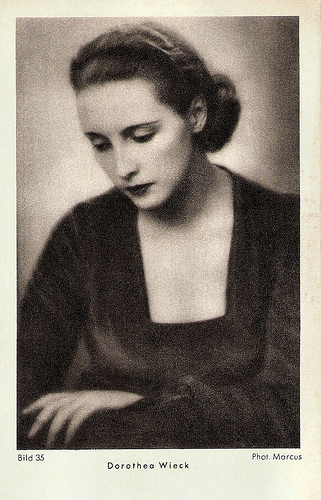
German postcard by Margarinewerk Eidelstedt Gebr. Fauser GmbH, Holstein. Serie 1, Bild 35. Photo: Marcus.
Supporting Roles
After the war, Dorothea Wieck was reported to be death. After the bombing of Dresden in February 1945, the actress had been buried for 4 days, but she survived though seriously injured. The German magazine Der Spiegel reported on 01/11/47: "Dorothea Wieck, the Berlin stage and film actress is not dead, as was reported incorrectly after the bombing of Dresden in 1944 (sic)." The following tear, she would return to the theatre and make a stage tour.
In the 1950s followed interesting supporting roles in films like Herz der Welt/The Alfred Nobel Story (Harald Braun, 1952) with Dieter Borsche , Man on a Tightrope (Elia Kazan, 1953) starring Frederic March, Das Fräulein von Scuderi/The Miss from Scuderi (Eugen York, 1955) featuring the legendary Henny Porten , the Heimatfilm Das Forsthaus in Tirol/The forester`s house in Tirol(Hermann Kugelstadt, 1955), A Time to Love and a Time to Die (Douglas Sirk, 1958), and Menschen im Hotel/Grand Hotel (Gottfried Reinhardt, 1959) with Michèle Morgan .
After that she retired from the film business more or less. To her last films belong Die Schachnovelle/Brainwashed (Gerd Oswald, 1960) with Curd Jürgens and Das Mädchen und der Staatsanwalt/The girl and the prosecutor (Jürgen Goslar, 1962).
Between 1961 and 1967, Wieck taught acting at her own academy in Berlin. On TV she played in two episodes of the Krimi series Der Kommissar in 1969 and 1973. In 1973 she was awarded for her work with the Filmband in Gold.
Dorothea Wieck passed away in 1986 in Berlin, at the age of 78. She is not forgotten and has still many fans, because of her role in Mädchen in Uniform. At IMDb , reviewer Jan Onderwater notes: "The direction of Sagan/Froelich and the cinematography are outstanding, but it could never have become the classic it is if both Hertha Thiele and Dorothea Wieck had not been in the lead. Photogenic Thiele plays Manuela as a sensitive, but still proud girl; Wieck gives the Von Bernburg character all the subtleties and uncertainties it needs."
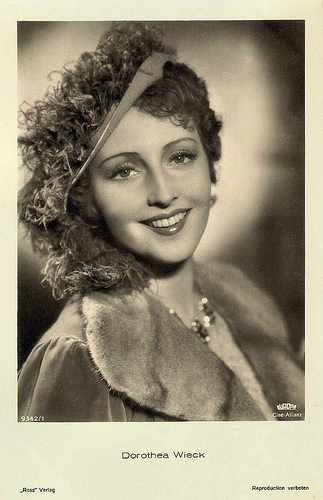
German postcard by Ross Verlag, Berlin, no. 9342/1, 1935-1936. Photo: Europa / Cine-Allianz. Publicity still for Der Student von Prag/The Student of Prague (Arthur Robison, 1935).
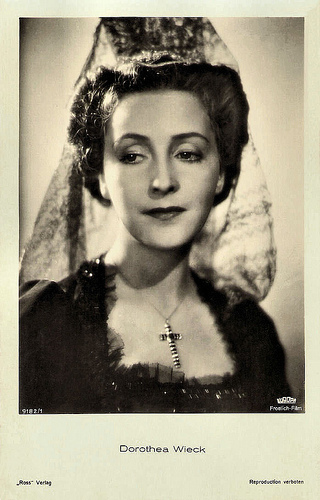
German postcard by Ross Verlag, Berlin, no. 9182/1, 1935-1936. Photo: Europa / Froelich-Film. Publicity still for Liselotte von der Pfalz (Carl Froelich, 1935).
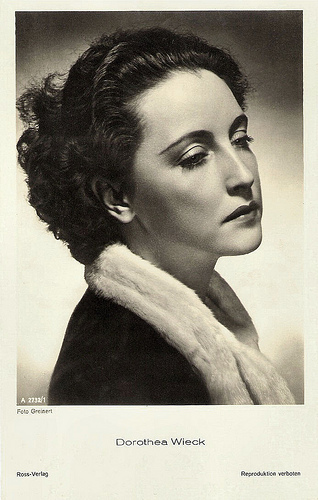
German postcard by Ross-Verlag, no. A 2732, 1939-1940. Photo: Greinert.
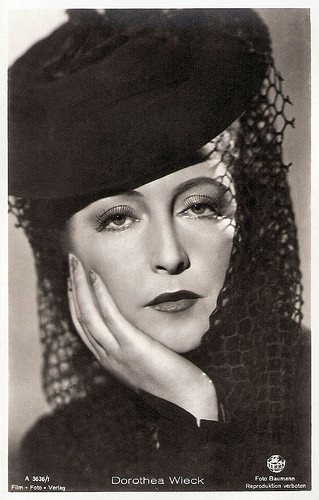
German postcard by Film-Foto-Verlag, Berlin, no. A 3628/1, 1941-1944. Photo: Baumann / Terra.
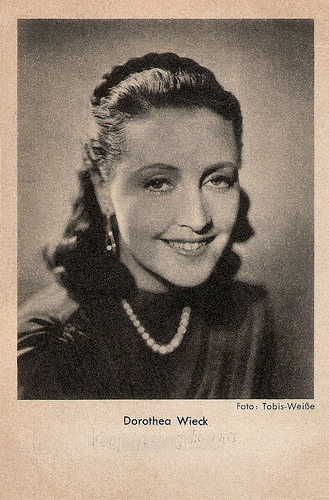
German postcard by 'Das Programm von heute', Zeitschrift für Film und Theater G.m.b.H., Berlin. Photo: Tobis-Weisse.
Sources: Bruce Eder (AllMovie), Stephanie D'heil (Steffi-line - German), (IMDb), Der Spiegel (German)Thomas Staedeli (Cyranos), Sandra Brennan (AllMovie), Wikipedia, and .

German postcard by Ross Verlag, Berlin, no. 6846/1, 1931-1932. Photo: Atelier Binder, Berlin.

German postcard by Ross Verlag, Berlin, no. 7447, 1932-1933. Photo: Gerty Simon, Berlin.

German postcard by Ross Verlag, Berlin, no. 7503/1, 1932-1933. Photo: Robertson, Berlin.

German postcard by Ross Verlag, Berlin, no. 7771/1, 1932-1933. Photo: Klagemann / Terra.

Dutch postcard, no. 558. Sent by mail in 1934. Photo: Paramount.
Silent Films
Dorothea Olavia Wieck was born in Davos, Switzerland, in 1908. She was the daughter of wholesale merchant Hans Leopold Wieck and Friederike Wernicke. After spending most of her childhood in Sweden, Dorothea was schooled in Dresden. At the age of 12, she started to study dance and at 15, she attended acting courses by Maria Moissi, the first wife of Alexander Moissi, in Berlin.
She studied with Max Reinhardt and made her stage debut in Vienna at the Theater in der Josephstadt. Later she appeared in Munich at the Münchner Kammerspiele in plays by Carl Zuckmayer and Ferenc Molnár.
After being spotted by director Franz Seitz, she began her film career with a part in the comedy Heimliche Sünder/Secret Sinners (Franz Seitz, 1926), followed by a bigger role in Die kleine Inge und ihre drei Väter/Little Inge and Her Three Fathers (Franz Osten, 1926).
Soon followed more leading roles in silent films like Ich hab mein Herz in Heidelberg verloren/I Lost My Heart at Heidelberg (Arthur Bergen, 1926), Sturmflut/Storm Tide (Willy Reiber, 1927), and Der Fremdenlegionär/Foreign Legionaire (James Bauer, 1928) with Therese Giehse.
Her breakthrough followed after the introduction of sound film. She had an international success with the pioneering feminist film Mädchen in Uniform/Girls in Uniform (Leontine Sagan, Carl Froelich, 1931). Hertha Thiele co-starred as a sensitive girl, who is sent to an all-girls boarding school where she develops a romantic attachment to one of her teachers, Fräulein von Bernburg (Wieck).
First when the lesbian themed film was released in the United States it was banned. First Lady Eleanor Roosevelt saw the importance of the film though and the ban was lifted. Later in Germany the Nazi regime even tried to burn all the copies of the film, but they couldn't.
Bruce Eder at AllMovie : "it was attacked in its time, though not for the lesbian-oriented, homo-erotic aspects of its story and visuals, but for being a critique of the educational establishment. It thus became an underground classic, taken to heart by iconoclasts of all stripes and, most especially, by lesbian audiences. Even by the standards of the twenty-first century, the honesty of the movie is startling when one considers its origins. The technical side of the filmmaking may be a little frayed, but the acting and direction have endured in their appeal across many decades, and the movie continues to attract attention as something more than an artifact."

Austrian postcard by Iris Verlag, no. 995. Photo: Emelka.

German postcard by Ross Verlag, Berlin, no. 61/3, 1926. Photo: Münchner Lichtspielkunst AG (Emelka). Publicity still for Ich hab mein Herz in Heidelberg verloren/I Lost My Heart in Heidelberg (Arthur Bergen, 1926) with Werner Fuetterer .

Dutch Postcard by M. Bonnist & Zonen, Amsterdam, Z., no. 104 e. Photo: Fim Film, Amsterdam. Publicity still for Mädchen in Uniform/Girls in Uniform (Leontine Sagan, Carl Froelich, 1931).

British card in the series Film Shots by Film Weekly. Photo: Deutsche. Publicity still for Mädchen in Uniform/Girls in Uniform (Leontine Sagan, Carl Froelich, 1931) with Hertha Thiele .

German postcard by Ross Verlag, no. 164/2. Photo: Phoebus Tonfilm prod. Publicity still for Trenck (Ernst Neubach, Heinz Paul, 1932) with Theodoor Loos . Collection: Didier Hanson.

German postcard by Ross Verlag, no. 7265/1, 1932-1933. Photo: Phoebus Tonfilm Prod. Publicity still for Trenck - Der Roman einer großen Liebe/Trenck - The novel of a great love (Ernst Neubach, Heinz Paul, 1932).
Hollywood
In the years after Mädchen in Uniform, Dorothea Wieck starred in well-known productions like the operetta Gräfin Mariza/Countess Mariza (Richard Oswald, 1932), and Anna und Elisabeth (Frank Wisbar, 1933) again with Hertha Thiele .
In 1932, Wieck married baron Ernst von der Decken, a journalist and author. They were not often together and divorced in 1935.
The international success of Mädchen in Uniform led her to Hollywood where she starred in two films, Cradle Song (Mitchell Leisen, 1933) and Miss Fane's Baby Is Stolen (Alexander Hall, 1934), based on the Lindbergh kidnapping case. Both films flopped at the box office and this, combined with accusations of espionage for the Nazis, forced her return to Germany.
In the following years Wieck played in such popular films as Der Student von Prag/The Student of Prague (Arthur Robison, 1935) starring Adolf Wohlbrück (Anton Walbrook), and Die gelbe Flagge/The Yellow Flagg (Gerhard Lamprecht, 1937) with Hans Albers .
During wartime Dorothea Wieck turned her attention to the theatre, and also worked as a stage director. As a celebrated actress, she was repeatedly dinner partner of Chancellor Hitler. She occasionally appeared in front of the camera in the propaganda film Kopf hoch, Johannes!/Head up, Johannes! (Viktor de Kowa, 1941), Andreas Schlüter (Herbert Maisch, 1942) featuring Heinrich George , and Der Grüne Salon/The Green Room (Boleslaw Barlog, 1944). In Italy, she made Inviati speciali/Special Guests (Romolo Marcellini, 1943).

Dutch postcard, printed by Smeets & Schippers, Amsterdam. Photo: Paramount.

Dutch postcard by M. Bonnist & Zonen, Amsterdam-Z., no. B 299. Photo: Paramount. Publicity still for Cradle Song (Mitchell Leisen, 1933).

German postcard by Ross Verlag. Photo: Paramount.

German postcard by Ross Verlag, Berlin, no. 8448/2, 1933-1934. Photo: Paramount.

German postcard by Margarinewerk Eidelstedt Gebr. Fauser GmbH, Holstein. Serie 1, Bild 35. Photo: Marcus.
Supporting Roles
After the war, Dorothea Wieck was reported to be death. After the bombing of Dresden in February 1945, the actress had been buried for 4 days, but she survived though seriously injured. The German magazine Der Spiegel reported on 01/11/47: "Dorothea Wieck, the Berlin stage and film actress is not dead, as was reported incorrectly after the bombing of Dresden in 1944 (sic)." The following tear, she would return to the theatre and make a stage tour.
In the 1950s followed interesting supporting roles in films like Herz der Welt/The Alfred Nobel Story (Harald Braun, 1952) with Dieter Borsche , Man on a Tightrope (Elia Kazan, 1953) starring Frederic March, Das Fräulein von Scuderi/The Miss from Scuderi (Eugen York, 1955) featuring the legendary Henny Porten , the Heimatfilm Das Forsthaus in Tirol/The forester`s house in Tirol(Hermann Kugelstadt, 1955), A Time to Love and a Time to Die (Douglas Sirk, 1958), and Menschen im Hotel/Grand Hotel (Gottfried Reinhardt, 1959) with Michèle Morgan .
After that she retired from the film business more or less. To her last films belong Die Schachnovelle/Brainwashed (Gerd Oswald, 1960) with Curd Jürgens and Das Mädchen und der Staatsanwalt/The girl and the prosecutor (Jürgen Goslar, 1962).
Between 1961 and 1967, Wieck taught acting at her own academy in Berlin. On TV she played in two episodes of the Krimi series Der Kommissar in 1969 and 1973. In 1973 she was awarded for her work with the Filmband in Gold.
Dorothea Wieck passed away in 1986 in Berlin, at the age of 78. She is not forgotten and has still many fans, because of her role in Mädchen in Uniform. At IMDb , reviewer Jan Onderwater notes: "The direction of Sagan/Froelich and the cinematography are outstanding, but it could never have become the classic it is if both Hertha Thiele and Dorothea Wieck had not been in the lead. Photogenic Thiele plays Manuela as a sensitive, but still proud girl; Wieck gives the Von Bernburg character all the subtleties and uncertainties it needs."

German postcard by Ross Verlag, Berlin, no. 9342/1, 1935-1936. Photo: Europa / Cine-Allianz. Publicity still for Der Student von Prag/The Student of Prague (Arthur Robison, 1935).

German postcard by Ross Verlag, Berlin, no. 9182/1, 1935-1936. Photo: Europa / Froelich-Film. Publicity still for Liselotte von der Pfalz (Carl Froelich, 1935).

German postcard by Ross-Verlag, no. A 2732, 1939-1940. Photo: Greinert.

German postcard by Film-Foto-Verlag, Berlin, no. A 3628/1, 1941-1944. Photo: Baumann / Terra.

German postcard by 'Das Programm von heute', Zeitschrift für Film und Theater G.m.b.H., Berlin. Photo: Tobis-Weisse.
Sources: Bruce Eder (AllMovie), Stephanie D'heil (Steffi-line - German), (IMDb), Der Spiegel (German)Thomas Staedeli (Cyranos), Sandra Brennan (AllMovie), Wikipedia, and .
Published on June 01, 2015 22:00
May 31, 2015
Norman Wisdom
English comedian and actor Norman Wisdom (1915–2010) starred in a series of hit comedies between 1953 and 1966. His trademark role was The Gump, in a jacket three sizes too small with tie awry and tweed cap askew, the eternal schoolboy with the looks of a beaten puppy. Wisdom became a celebrity in countries as far apart as South America, Iran and Albania. Wisdom later forged a career on Broadway in New York and as a television actor.
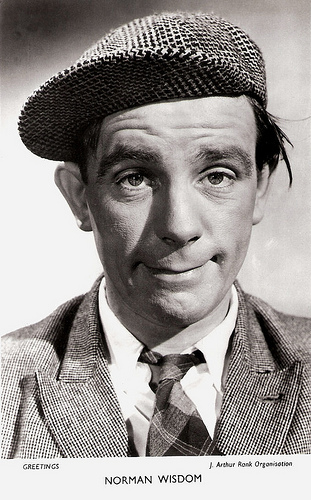
British postcard. Photo: J. Arthur Rank Organisation.
A star is born!
Norman Joseph Wisdom was born in London in 1915. His parents were Frederick, a chauffeur, and Maud Wisdom (née Targett), a dressmaker who often worked for West End theatres, and had made a dress for Queen Mary. Norman and his brother Fred were raised in extreme poverty and were frequently hit by their father.
After a period in a children's home, Wisdom ran away when he was 11 but returned to become an errand boy in a grocer's shop on leaving school at 13. Having been kicked out of his home by his father in 1929 he became a cabin boy in the Merchant Navy. Wisdom enlisted into the King's Own Royal Regiment, but his mother had him discharged as he was under age. He later re-enlisted as a drummer boy in the 10th Royal Hussars of the British Army.
In 1930 he was posted to Lucknow, in the United Provinces of British India, as a bandsman. There he gained an education certificate, rode horses, became the flyweight boxing champion of the British Army in India and learned to play the trumpet and clarinet. At the outbreak of the Second World War, Wisdom was sent to work in a communications centre in a command bunker in London where he connected telephone calls from war leaders to the prime minister. He met Winston Churchill on several occasions when asked for updates on incoming calls, and once was disciplined for calling him Winnie.
Whilst performing a shadow boxing routine in the army gym, Wisdom discovered he had a talent for entertainment. He began to develop his skills as a musician and stage entertainer. In 1940 aged 25, at a NAAFI entertainment night, during a dance routine, Wisdom stepped-down from his position in the orchestra pit, and started shadow boxing. Hearing his colleagues and officers giggles, he broke into a duck-waddle, followed by a series of facial expressions. Over the next few years, until he was demobilized in 1945, his routine would be suffixed with his characteristic singing and the trip-up-and-stumble.
After the war his variety debut came at the old Collins Music Hall on Islington Green, north London, in 1945, and he started touring Britain in pantomime and summer shows. In 1948 he made his first West End appearance, on a variety bill at the London Casino, and became famous virtually overnight. "A star is born!" announced the Daily Mail , and the following week Wisdom went straight to the top of the bill at the Golders Green Hippodrome, north London.
His next date was a summer show with the magician David Nixon, and for this appearance he meticulously worked out the characterisation for which he became famous: variously known as Norman or The Gump or Pitkin – an enthusiastic, puppyish little man with a too-tight tweed jacket and crooked cap. Attired as such, and complete with the later familiar jerky gait and propensity for sudden collapses, he played a volunteer who came out of the audience to help – and, of course, reduce to a shambles – Nixon's magic act.

German postcard by Ufa, Berlin-Tempelhof, no. FK 988. Photo: J. Arthur Rank Organisation. Publicity still for Trouble in Store (John Paddy Carstairs, 1953).
A Cult Figure in Albania
Norman Wisdom made a series of low-budget star-vehicle comedies for the Rank Organisation, beginning with Trouble in Store (John Paddy Carstairs, 1953) with Lana Morris and Margaret Rutherford. This film earned him a BAFTA Award for Most Promising Newcomer to Film in 1954. The film broke box office records at 51 out of the 67 London cinemas in which it played and was the second most popular film at the British box office in 1954.
The follow-up was One Good Turn (John Paddy Carstairs, 1955) co-starring Joan Rice. It was the 7th most popular film at the British box office in 1955. Other comedies were Man of the Moment (John Paddy Carstairs, 1955) with Belinda Lee , Up in the World (John Paddy Carstairs, 1956) with Maureen Swanson , and The Square Peg (John Paddy Carstairs, 1958) with Honor Blackman .
The series peaked commercially with A Stitch in Time (Robert Asher, 1963). His films' cheerful, unpretentious appeal make them the direct descendants of those made a generation earlier by George Formby . Never highly thought of by the critics, they were very popular with domestic audiences and Wisdom's films were among Britain's biggest box office successes of their day.
They were also successful in some unlikely overseas markets, helping Rank stay afloat financially when their more expensive film projects were unsuccessful. Wisdom was a cult figure in Albania, where he was one of the few Western actors whose films were allowed in the country during the dictatorship of Enver Hoxha. In Hoxha's view, proletarian Norman's ultimately victorious struggles against capitalism, personified by Mr. Grimsdale and the effete aristocratic characters played by Jerry Desmonde, were a Communist parable on the class war. He was known as Mr Pitkin after the character from his films. In 1995, he visited the post-Stalinist country where, to his surprise, he was greeted by many appreciative fans, including the then President, Sali Berisha. During this trip, Wisdom was filmed by Newsnight as he visited a children's project funded by ChildHope UK.
His films usually involved the Gump character, Norman Pitkin, in a manual occupation in which he is barely competent and in a junior position to a straight man, often played by Edward Chapman (as Mr Grimsdale) or Jerry Desmonde. They benefited from Wisdom's capacity for physical slapstick comedy and his skill at creating a sense of the character's helplessness. The series often contained a romantic subplot; the Gump's inevitable awkwardness with women is a characteristic shared with the earlier Formby vehicles. His innocent incompetence still made him endearing to the heroine.
Wisdom made two films independently in order to extend his range, one of which, There Was a Crooked Man (Stuart Burge, 1960) is according Richard Dacre in Encyclopedia of British Cinema , amongst his finest, but the cinema public craved only the Gump.
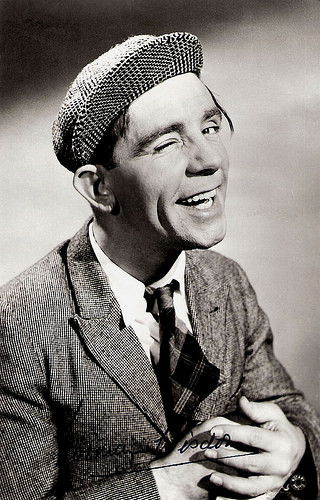
British postcard by Rotary Photo. Photo: J. Arthur Rank Organisation.
Going Gently
In 1966, Norman Wisdom went to the United States to star in a Broadway production of the Jimmy Van Heusen and Sammy Cahn musical comedy Walking Happy. His performance was nominated for a Tony Award.
He also completed his first American film as a vaudeville comic in The Night They Raided Minsky's (William Friedkin, 1968) with Jason Robards and Britt Ekland. After a typical performance on The Ed Sullivan Show, further US opportunities were denied him when he had to return to London after his second wife left him.
In 1969 he made a fairly sophisticated sex comedy, What's Good for the Goose (Menahem Golan, 1969), in which he did a bedroom scene with Sally Geeson. His public was not ready for the little Gump in bed with a woman, and Wisdom's career as a top film comedian was over.
His subsequent career was largely confined to television, and he toured the world with a successful cabaret act. He won critical acclaim in 1981 for his dramatic role in the television play Going Gently (Stephen Frears, 1981). In this harrowing play, set in the cancer ward of a London hospital, he portrayed a retired salesman unable to come to terms with terminal illness. For once the pathos was unforced, and Wisdom triumphed in a difficult role, winning a BAFTA Award.
In 1992 he played a retired burglar in a film thriller, Double X: The Name of the Game (Shani S. Grewal, 1992), which sank almost without trace.
Wisdom became prominent again in the 1990s, helped by the young comedian Lee Evans, whose act was often compared to Wisdom's work. His classic Rank films were playing to new audiences on television screens and DVD, with a growing number of new young fans in the United Kingdom and abroad. The high point of this new popularity was the knighthood he was awarded, for services to entertainment, in the 2000 new year's honours list. During the ceremony, once he had received his knighthood, he walked away and again performed his trademark trip at which the Queen smiled and laughed.
From 1995 until 2004 he appeared in the recurring role of Billy Ingleton in the long-running BBC comedy Last of the Summer Wine. The role was originally a one-off appearance, but proved so popular that he returned as the character on a number of occasions. In 1996, he received a Special Achievement Award from the London Film Critics.
In 2002 Wisdom filmed a cameo role as a butler in a low budget horror film, Evil Calls: The Raven (2008). In 2004, he made an appearance on Coronation Street, playing fitness fanatic pensioner Ernie Crabbe. In 2005, Wisdom announced his retirement from the entertainment industry on his 90th birthday. He intended to spend more time with his family, playing golf and driving around the Isle of Man, where he was living.
In 2007 he came out of retirement to take a role in a short film called Expresso (Kevin Powis, 2007), set during one day in a coffee shop. Wisdom plays a vicar plagued by a fly in the café. The film premièred at the Cannes Film Festival 2007. Producer Nigel Martin Davey gave him only a visual role so he would not have to remember any lines, but on the day Wisdom was alert and had his performance changed to add more laughs.
A year later he played a cameo in the horror film The Legend of Harrow Woods (Robert Driscoll, 2008). Wisdom published the autobiography Don't Laugh At Me (1992) and Richard Dacre wrote the biography Trouble in Store (1991).
Wisdom was married twice. His first wife was Doreen Brett, whom he married in 1941. By 1944 they had separated when Doreen gave birth to a son, Michael (1944), fathered by Albert Gerald Hardwick, a telephone engineer. The marriage was dissolved in 1946. He married his second wife, Freda Isobel Simpson, a dancer, in 1947; they had two children: Nicholas (born 1953, who later played first-class cricket for Sussex) and Jacqueline (1954). The couple divorced in 1969, with Wisdom granted full custody of the children.
Norman Wisdom died in 2010 at Abbotswood nursing home on the Isle of Man at the age of 95. Stephen Dixon in his obituary in The Guardian : “Wisdom was almost the last in a great tradition of knockabout, slapstick clowns, a performer who relied less on words than on an acrobatic physical dexterity to gain his laughs.”
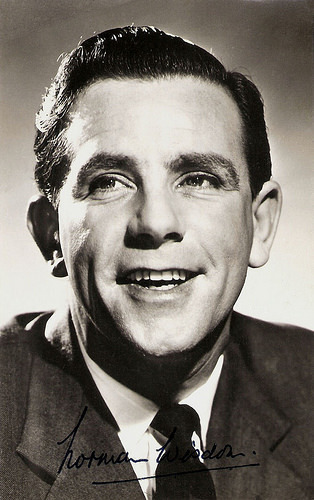
British autograph card. Sent by mail in 1958. Photo: J. Arthur Rank Organisation.
Sources: Stephen Dixon (The Guardian), Richard Dacre (Encyclopedia of British Cinema), The Telegraph, Wikipedia and .

British postcard. Photo: J. Arthur Rank Organisation.
A star is born!
Norman Joseph Wisdom was born in London in 1915. His parents were Frederick, a chauffeur, and Maud Wisdom (née Targett), a dressmaker who often worked for West End theatres, and had made a dress for Queen Mary. Norman and his brother Fred were raised in extreme poverty and were frequently hit by their father.
After a period in a children's home, Wisdom ran away when he was 11 but returned to become an errand boy in a grocer's shop on leaving school at 13. Having been kicked out of his home by his father in 1929 he became a cabin boy in the Merchant Navy. Wisdom enlisted into the King's Own Royal Regiment, but his mother had him discharged as he was under age. He later re-enlisted as a drummer boy in the 10th Royal Hussars of the British Army.
In 1930 he was posted to Lucknow, in the United Provinces of British India, as a bandsman. There he gained an education certificate, rode horses, became the flyweight boxing champion of the British Army in India and learned to play the trumpet and clarinet. At the outbreak of the Second World War, Wisdom was sent to work in a communications centre in a command bunker in London where he connected telephone calls from war leaders to the prime minister. He met Winston Churchill on several occasions when asked for updates on incoming calls, and once was disciplined for calling him Winnie.
Whilst performing a shadow boxing routine in the army gym, Wisdom discovered he had a talent for entertainment. He began to develop his skills as a musician and stage entertainer. In 1940 aged 25, at a NAAFI entertainment night, during a dance routine, Wisdom stepped-down from his position in the orchestra pit, and started shadow boxing. Hearing his colleagues and officers giggles, he broke into a duck-waddle, followed by a series of facial expressions. Over the next few years, until he was demobilized in 1945, his routine would be suffixed with his characteristic singing and the trip-up-and-stumble.
After the war his variety debut came at the old Collins Music Hall on Islington Green, north London, in 1945, and he started touring Britain in pantomime and summer shows. In 1948 he made his first West End appearance, on a variety bill at the London Casino, and became famous virtually overnight. "A star is born!" announced the Daily Mail , and the following week Wisdom went straight to the top of the bill at the Golders Green Hippodrome, north London.
His next date was a summer show with the magician David Nixon, and for this appearance he meticulously worked out the characterisation for which he became famous: variously known as Norman or The Gump or Pitkin – an enthusiastic, puppyish little man with a too-tight tweed jacket and crooked cap. Attired as such, and complete with the later familiar jerky gait and propensity for sudden collapses, he played a volunteer who came out of the audience to help – and, of course, reduce to a shambles – Nixon's magic act.

German postcard by Ufa, Berlin-Tempelhof, no. FK 988. Photo: J. Arthur Rank Organisation. Publicity still for Trouble in Store (John Paddy Carstairs, 1953).
A Cult Figure in Albania
Norman Wisdom made a series of low-budget star-vehicle comedies for the Rank Organisation, beginning with Trouble in Store (John Paddy Carstairs, 1953) with Lana Morris and Margaret Rutherford. This film earned him a BAFTA Award for Most Promising Newcomer to Film in 1954. The film broke box office records at 51 out of the 67 London cinemas in which it played and was the second most popular film at the British box office in 1954.
The follow-up was One Good Turn (John Paddy Carstairs, 1955) co-starring Joan Rice. It was the 7th most popular film at the British box office in 1955. Other comedies were Man of the Moment (John Paddy Carstairs, 1955) with Belinda Lee , Up in the World (John Paddy Carstairs, 1956) with Maureen Swanson , and The Square Peg (John Paddy Carstairs, 1958) with Honor Blackman .
The series peaked commercially with A Stitch in Time (Robert Asher, 1963). His films' cheerful, unpretentious appeal make them the direct descendants of those made a generation earlier by George Formby . Never highly thought of by the critics, they were very popular with domestic audiences and Wisdom's films were among Britain's biggest box office successes of their day.
They were also successful in some unlikely overseas markets, helping Rank stay afloat financially when their more expensive film projects were unsuccessful. Wisdom was a cult figure in Albania, where he was one of the few Western actors whose films were allowed in the country during the dictatorship of Enver Hoxha. In Hoxha's view, proletarian Norman's ultimately victorious struggles against capitalism, personified by Mr. Grimsdale and the effete aristocratic characters played by Jerry Desmonde, were a Communist parable on the class war. He was known as Mr Pitkin after the character from his films. In 1995, he visited the post-Stalinist country where, to his surprise, he was greeted by many appreciative fans, including the then President, Sali Berisha. During this trip, Wisdom was filmed by Newsnight as he visited a children's project funded by ChildHope UK.
His films usually involved the Gump character, Norman Pitkin, in a manual occupation in which he is barely competent and in a junior position to a straight man, often played by Edward Chapman (as Mr Grimsdale) or Jerry Desmonde. They benefited from Wisdom's capacity for physical slapstick comedy and his skill at creating a sense of the character's helplessness. The series often contained a romantic subplot; the Gump's inevitable awkwardness with women is a characteristic shared with the earlier Formby vehicles. His innocent incompetence still made him endearing to the heroine.
Wisdom made two films independently in order to extend his range, one of which, There Was a Crooked Man (Stuart Burge, 1960) is according Richard Dacre in Encyclopedia of British Cinema , amongst his finest, but the cinema public craved only the Gump.

British postcard by Rotary Photo. Photo: J. Arthur Rank Organisation.
Going Gently
In 1966, Norman Wisdom went to the United States to star in a Broadway production of the Jimmy Van Heusen and Sammy Cahn musical comedy Walking Happy. His performance was nominated for a Tony Award.
He also completed his first American film as a vaudeville comic in The Night They Raided Minsky's (William Friedkin, 1968) with Jason Robards and Britt Ekland. After a typical performance on The Ed Sullivan Show, further US opportunities were denied him when he had to return to London after his second wife left him.
In 1969 he made a fairly sophisticated sex comedy, What's Good for the Goose (Menahem Golan, 1969), in which he did a bedroom scene with Sally Geeson. His public was not ready for the little Gump in bed with a woman, and Wisdom's career as a top film comedian was over.
His subsequent career was largely confined to television, and he toured the world with a successful cabaret act. He won critical acclaim in 1981 for his dramatic role in the television play Going Gently (Stephen Frears, 1981). In this harrowing play, set in the cancer ward of a London hospital, he portrayed a retired salesman unable to come to terms with terminal illness. For once the pathos was unforced, and Wisdom triumphed in a difficult role, winning a BAFTA Award.
In 1992 he played a retired burglar in a film thriller, Double X: The Name of the Game (Shani S. Grewal, 1992), which sank almost without trace.
Wisdom became prominent again in the 1990s, helped by the young comedian Lee Evans, whose act was often compared to Wisdom's work. His classic Rank films were playing to new audiences on television screens and DVD, with a growing number of new young fans in the United Kingdom and abroad. The high point of this new popularity was the knighthood he was awarded, for services to entertainment, in the 2000 new year's honours list. During the ceremony, once he had received his knighthood, he walked away and again performed his trademark trip at which the Queen smiled and laughed.
From 1995 until 2004 he appeared in the recurring role of Billy Ingleton in the long-running BBC comedy Last of the Summer Wine. The role was originally a one-off appearance, but proved so popular that he returned as the character on a number of occasions. In 1996, he received a Special Achievement Award from the London Film Critics.
In 2002 Wisdom filmed a cameo role as a butler in a low budget horror film, Evil Calls: The Raven (2008). In 2004, he made an appearance on Coronation Street, playing fitness fanatic pensioner Ernie Crabbe. In 2005, Wisdom announced his retirement from the entertainment industry on his 90th birthday. He intended to spend more time with his family, playing golf and driving around the Isle of Man, where he was living.
In 2007 he came out of retirement to take a role in a short film called Expresso (Kevin Powis, 2007), set during one day in a coffee shop. Wisdom plays a vicar plagued by a fly in the café. The film premièred at the Cannes Film Festival 2007. Producer Nigel Martin Davey gave him only a visual role so he would not have to remember any lines, but on the day Wisdom was alert and had his performance changed to add more laughs.
A year later he played a cameo in the horror film The Legend of Harrow Woods (Robert Driscoll, 2008). Wisdom published the autobiography Don't Laugh At Me (1992) and Richard Dacre wrote the biography Trouble in Store (1991).
Wisdom was married twice. His first wife was Doreen Brett, whom he married in 1941. By 1944 they had separated when Doreen gave birth to a son, Michael (1944), fathered by Albert Gerald Hardwick, a telephone engineer. The marriage was dissolved in 1946. He married his second wife, Freda Isobel Simpson, a dancer, in 1947; they had two children: Nicholas (born 1953, who later played first-class cricket for Sussex) and Jacqueline (1954). The couple divorced in 1969, with Wisdom granted full custody of the children.
Norman Wisdom died in 2010 at Abbotswood nursing home on the Isle of Man at the age of 95. Stephen Dixon in his obituary in The Guardian : “Wisdom was almost the last in a great tradition of knockabout, slapstick clowns, a performer who relied less on words than on an acrobatic physical dexterity to gain his laughs.”

British autograph card. Sent by mail in 1958. Photo: J. Arthur Rank Organisation.
Sources: Stephen Dixon (The Guardian), Richard Dacre (Encyclopedia of British Cinema), The Telegraph, Wikipedia and .
Published on May 31, 2015 22:00
May 30, 2015
Michel Paje
French singer and songwriter Michel Paje (1945) was one of the yéyé pop stars of the early 1960s. He worked for the cinema as an actor and composer and is now known as a voice actor under his real name Michel Roy.
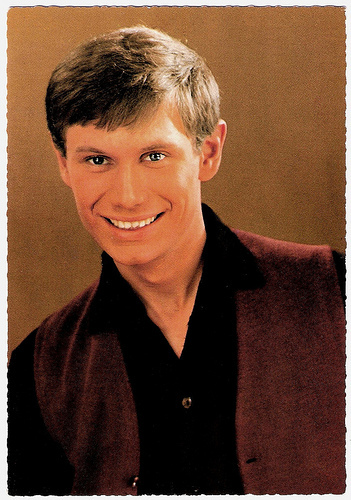
French postcard by Publistar, Marseille, no. 1190. Photo: P.P.P. / Vogue.
Yéyé Star
Michel Paje was born as Michel Roy in 1945 in Paris. He attended the boarding school St Nicolas in Issy-les-Moulineaux. During his youth, he had several jobs: assistant to a photographer, lighting assistant at the cabaret Le Milliardaire, employee of a British insurance company.
At the same time he took singing lessons with Jean Lumière, Charles Humel (the composer of Plaines du Far West for Yves Montand ), and Christiane Néré where he met Alain Barrière and Isabelle Aubret.
He also took drama courses with René Simon a.o. He won the 1st prize Dramatic Art, Classical Section, at the Maubel conservatory in a play by Alfred de Musset. He played in a film and on stage at the festival of Enghien. But soon he chose for the music.
Paje became a star of the yéyé (French pop style) singer and recorded his first single in 1963: Tu peux pleurer (You can cry). His next song Nous on est dans le vent (We're in the wind) was one of the summer hits of 1963. It was later used for the soundtrack of the film comedy Jet-Set (Fabien Onteniente, 2000) with Samuel Le Bihan and Lambert Wilson .
In the following years he recorded several singles and two albums. His song On a l'âge de raison, mais on n'a jamais raison would be his greatest hit.

French postcard by Editions Starama, no. 868. Photo: Nisak / Vogue.
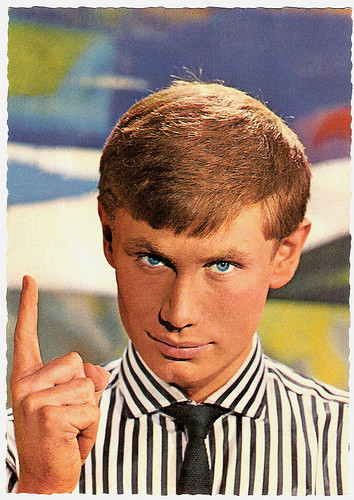
French postcard by Publistar, Marseille, no. 973. Photo: Vogue.
Apothéose porno
Michel Paje continued his singing career in Canada where he had his own TV show À la page (1967). In Montréal, he composed a song for the Expo 67, Bonjour Montréal, of which he also made an English version, Hello Montréal.
In 1968 Michel met actress Danielle Ouimet, the hope of the Canadian cinema. They made the Canadian film Tendre et sensuelle Valérie/Valérie (Denis Héroux, 1968) for which he composed the music and played a small part. The director Denis Héroux later became a major producer of well-known French and American films.
Paje also recorded two duets with Danielle Ouimet in 1968 and 1969. Back in France, Paje worked under his own name Michel Roy as a host and producer for the popular radio station Europe 1 in 1969.
He composed soundtracks for such films as the short Comme larrons en foire/Thick as thieves (Edmond Freess, 1970), the Spanish film Los farsantes del amor/The love fakers (Juan Xiol, 1972) and the adult comedy Apothéose porno (Jean-Marie Ghanassia, 1976).
He also composed music for the TV series Recherche dans l'intérêt des familles/Research for the benefit of families (1977) and for commercials. He continued to record until the mid-1970s, often under the alias Alain Jory.
In 2006 he moved to Moscow. According to Wikipedia he worked there on the film Au service du Roi and dubbed the role of King Louis XIV.
Today he is the official voice of the French TV station BFM TV. Michel Roy also works as a voice actor on films, TV programmes, commercials and trailers.
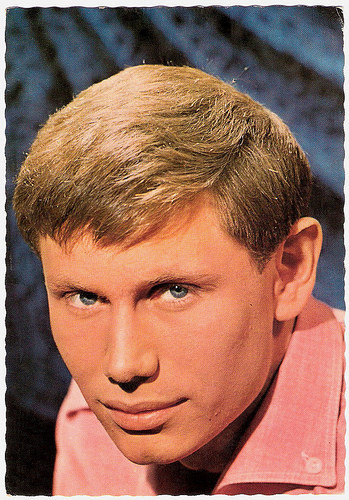
French postcard by Publistar, Marseille, no. 869. Photo: Nisak / Vogue.
Michel Paje sings Nous on est dans le vent (1963). Source: Valetdecoeurs (YouTube).
Sources: Retro Jeunesse 60 (French), Michelpaje.fr (French), Wikipedia (French) and .

French postcard by Publistar, Marseille, no. 1190. Photo: P.P.P. / Vogue.
Yéyé Star
Michel Paje was born as Michel Roy in 1945 in Paris. He attended the boarding school St Nicolas in Issy-les-Moulineaux. During his youth, he had several jobs: assistant to a photographer, lighting assistant at the cabaret Le Milliardaire, employee of a British insurance company.
At the same time he took singing lessons with Jean Lumière, Charles Humel (the composer of Plaines du Far West for Yves Montand ), and Christiane Néré where he met Alain Barrière and Isabelle Aubret.
He also took drama courses with René Simon a.o. He won the 1st prize Dramatic Art, Classical Section, at the Maubel conservatory in a play by Alfred de Musset. He played in a film and on stage at the festival of Enghien. But soon he chose for the music.
Paje became a star of the yéyé (French pop style) singer and recorded his first single in 1963: Tu peux pleurer (You can cry). His next song Nous on est dans le vent (We're in the wind) was one of the summer hits of 1963. It was later used for the soundtrack of the film comedy Jet-Set (Fabien Onteniente, 2000) with Samuel Le Bihan and Lambert Wilson .
In the following years he recorded several singles and two albums. His song On a l'âge de raison, mais on n'a jamais raison would be his greatest hit.

French postcard by Editions Starama, no. 868. Photo: Nisak / Vogue.

French postcard by Publistar, Marseille, no. 973. Photo: Vogue.
Apothéose porno
Michel Paje continued his singing career in Canada where he had his own TV show À la page (1967). In Montréal, he composed a song for the Expo 67, Bonjour Montréal, of which he also made an English version, Hello Montréal.
In 1968 Michel met actress Danielle Ouimet, the hope of the Canadian cinema. They made the Canadian film Tendre et sensuelle Valérie/Valérie (Denis Héroux, 1968) for which he composed the music and played a small part. The director Denis Héroux later became a major producer of well-known French and American films.
Paje also recorded two duets with Danielle Ouimet in 1968 and 1969. Back in France, Paje worked under his own name Michel Roy as a host and producer for the popular radio station Europe 1 in 1969.
He composed soundtracks for such films as the short Comme larrons en foire/Thick as thieves (Edmond Freess, 1970), the Spanish film Los farsantes del amor/The love fakers (Juan Xiol, 1972) and the adult comedy Apothéose porno (Jean-Marie Ghanassia, 1976).
He also composed music for the TV series Recherche dans l'intérêt des familles/Research for the benefit of families (1977) and for commercials. He continued to record until the mid-1970s, often under the alias Alain Jory.
In 2006 he moved to Moscow. According to Wikipedia he worked there on the film Au service du Roi and dubbed the role of King Louis XIV.
Today he is the official voice of the French TV station BFM TV. Michel Roy also works as a voice actor on films, TV programmes, commercials and trailers.

French postcard by Publistar, Marseille, no. 869. Photo: Nisak / Vogue.
Michel Paje sings Nous on est dans le vent (1963). Source: Valetdecoeurs (YouTube).
Sources: Retro Jeunesse 60 (French), Michelpaje.fr (French), Wikipedia (French) and .
Published on May 30, 2015 22:00
May 29, 2015
Het meisje met de blauwe hoed (1934)
Het meisje met de blauwe hoed/The girl with the blue hat (1934) is a Dutch 'army film', directed by Austrian director Rudolf Meinert. Stars are Roland Varno, Truus van Aalten and Lou Bandy. The film is an adaptation of the book Het meisje met de blauwe hoed by Johan Fabricius and was remade in 1972 as a popular television series with colour and new songs.
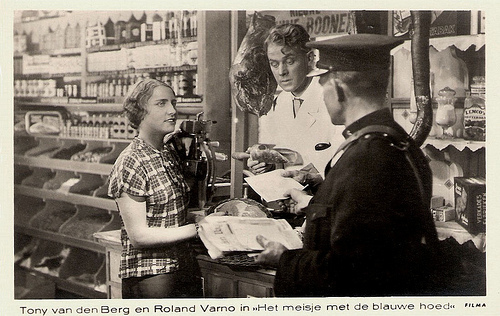
Dutch postcard by M. B.& Z. (M. Bonnist & Zonen, Amsterdam). Photo: Filma.Publicity still for Het Meisje met de Blauwe Hoed/The girl with the blue hat (Rudolf Meinert, 1934) with Tony van den Berg and Roland Varno .
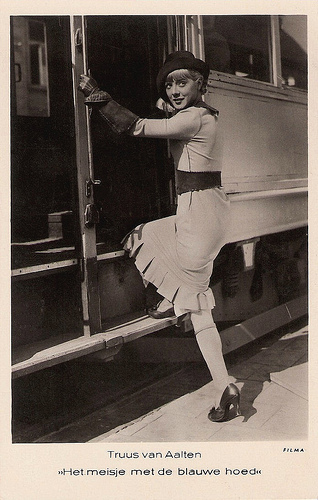
Dutch postcard by M. B.& Z. (M. Bonnist & Zonen, Amsterdam). Photo: Filma. Publicity still for Het meisje met den blauwen hoed/ The Girl with the Blue Hat (Rudolf Meinert, 1934) with Truus van Aalten . Collection: Egbert Barten. Comment by Ali Gardener at Flickr : "It looks like taken very spontaneous and still so perfectly posed! I like also the shadow of the shoes and all those splendid details."
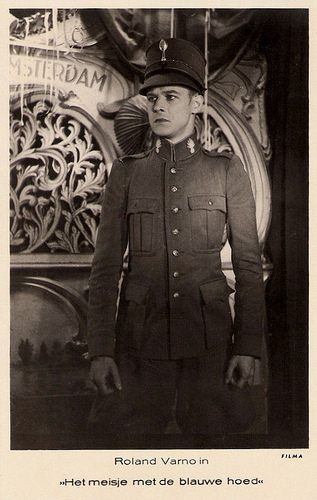
Dutch postcard by M. B.& Z. (M. Bonnist & Zonen, Amsterdam). Photo: Filma. Publicity still for Het meisje met de blauwe hoed/The Girl With the Blue Hat (Rudolf Meinert, 1934) with Roland Varno . Collectie: Egbert Barten.
Unusual for the Netherlands
Het meisje met de blauwe hoed/The girl with the blue hat was an unusual production for the Netherlands in the 1930s. It was the first production by Filma, the film production company of 27 years old Wil Tuschinski, son of cinema chain owner Abraham Tuschinski. For the first time, a moving camera was used in the Cinetone Sound Film studios in Amsterdam. The production costs amounted to 100,000 guilders - a record for the Dutch film industry at the time.
The three stars were also interesting. Dutch-born actor Roland Varno (1908-1996) is best known for his role as one of the schoolboys in Josef von Sternberg's Der blaue Engel/The blue angel (1930). He appeared in several German and Dutch films of the early 1930s and then moved to Hollywood, where he made a film with Greta Garbo , As You Desire me (George Fitzmaurice, 1932). However, he mostly worked in Hollywood as a character actor, often in B-pictures.
The female leading role was played by another Dutch film star with a career abroad, Truus van Aalten (1910-1999). She starred in 29 European films during the 1920s and 1930s. She made most of them in Berlin and Vienna, and Het Meisje met de Blauwe Hoed/The girl with the blue hat was the only film she made in the Netherlands.
Singer and entertainer Lou Bandy (1890-1959) played a dual role in Het meisje met de blauwe hoed/The girl with the blue hat as Toontje and as himself. Bandy was one of the most popular artists of The Netherlands between the two world wars. His songs Zoek de zon op (Look for the sun) and Louise zit niet op je nagels te bijten (Louise, don't bite your nails) became Dutch evergreens. In this film, Bandy sings the songs In de petoet (In the brig) and Vaste verkering (Steady dating) which soon became hits in the Netherlands.
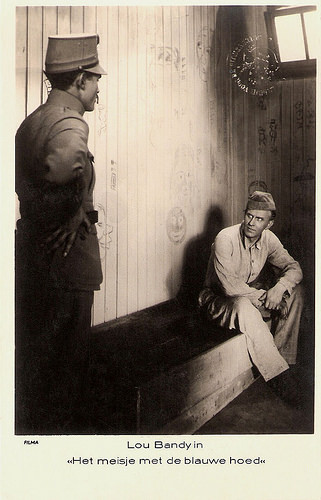
Dutch postcard by M. B. & Z. (M. Bonnist & Zonen, Amsterdam). Photo: Filma. Publicity still for Het Meisje met de Blauwe Hoed/The girl with the blue hat (Rudolf Meinert, 1934) with Lou Bandy .
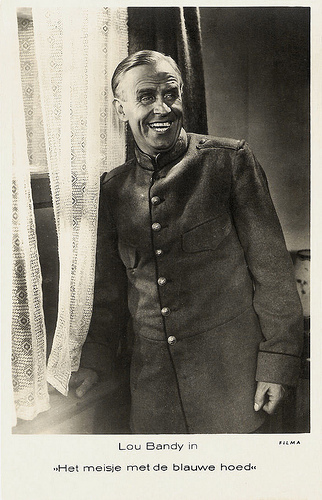
Dutch postcard by M. B. & Z. (M. Bonnist & Zonen, Amsterdam). Photo: Filma. Publicity still for Het Meisje met de Blauwe Hoed/The girl with the blue hat (Rudolf Meinert, 1934) with Lou Bandy .
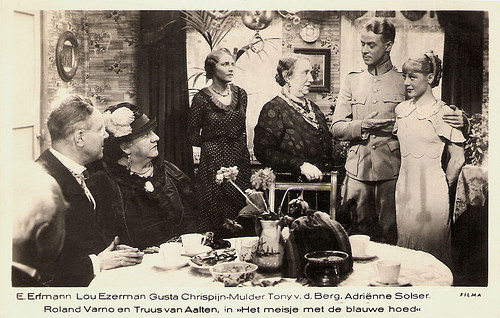
Dutch postcard by M. B. & Z. (M. Bonnist & Zonen, Amsterdam). Photo: Filma. Publicity still for Het Meisje met de Blauwe Hoed/The girl with the blue hat (Rudolf Meinert, 1934) with Eberhard Erfmann, Lau Ezerman , Gusta Chrispijn-Mulder, Tony van den Berg, Adrienne Solser, Roland Varno and Truus van Aalten .
Too wild for him
The film is also described as an army comedy. The story was based on a semi-autobiographical novel which Johan Fabricius published in 1927 and follows the story quite well. Roland Varno plays nerdy Daantje Pieters, who works in a grocery shop in Gouda when he is suddenly called to The Hague to serve for the Dutch army.
In the army, Daantje is the victim of teasing of his fellow soldiers. Especially his roommate Toontje ( Lou Bandy ) has great pleasure in keeping him fooled. The only thing that keeps Daantje going is the thought of 'the girl with the blue hat' ( Truus van Aalten ), a beautiful girl he spotted aboard the train to the garrison.
Despite the unfriendly beginning, smart and sneaky conman Toontje takes Daantje under his wing (not to mention his grocery supplies). During a visit to a revue of Lou Bandy Daantje notices again the girl with the blue hat. He is too shy to approach her, but Toontje arranges a meeting in a bar, to the chagrin of her date. The girl, who answers to the name Betsy, is attracted to Daantje and the two spend a romantic evening.
Daantjes mother (Adriënne Solser) is not impressed by the sexually liberated Betsy and sees her son would rather marry his neighbour Hilda Jansma (Tony van den Berg). Back in The Hague Betsy realizes that she and Danny do not fit together. She explains that she is too wild for him and breaks off the engagement.
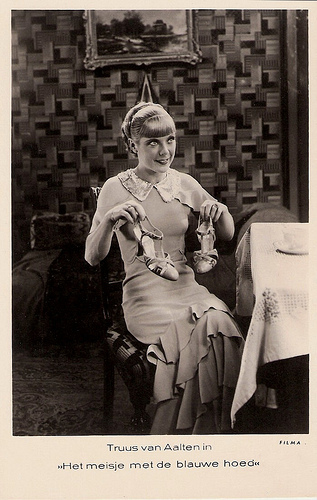
Dutch postcard by M. B.& Z. (M. Bonnist & Zonen, Amsterdam). Photo: Filma. Publicity still for Het Meisje met de Blauwe Hoed/The girl with the blue hat (Rudolf Meinert, 1934) with Truus van Aalten .
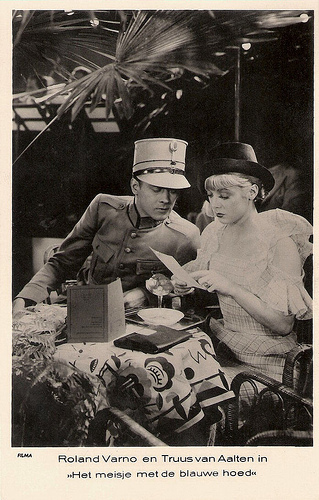
Dutch postcard by M. B.& Z. (M. Bonnist & Zonen, Amsterdam). Photo: Filma. Publicity still for Het Meisje met de Blauwe Hoed/The girl with the blue hat (Rudolf Meinert, 1934) with Roland Varno and Truus van Aalten .
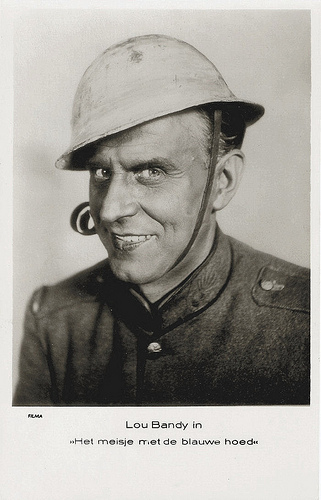
Dutch postcard by M. B. & Z. (M. Bonnist & Zonen, Amsterdam). Photo: Filma. Publicity still for Het Meisje met de Blauwe Hoed/The girl with the blue hat (1934) with Lou Bandy .
War Propaganda
During the Second World War, Het Meisje met de Blauwe Hoed/The girl with the blue hat was banned by the Nazis along with two other Dutch films, De Big van het Regiment/The Regiment's Mascot (Max Nosseck, 1935) and Ergens in Nederland/Somewhere in the Netherlands (Ludwig Berger, 1940) because of 'war propaganda'.
Chip Douglas at IMDb loves the film: "As a piece of Dutch cinema history this film is a clear standout. " About Varno and Van Aalten he notes: "They play their parts well, but it is Bandy who dominates the picture. His contribution, as well as the musical numbers managed to bring in a large enough audience to break even. However, writer Fabricius apparently wasn't very pleased when he found out they turned his book into a musical."
In 1972, a seven-part Dutch television series was broadcast, Het Meisje met de Blauwe Hoed/The girl with the blue hat (Dick van 't Sant, 1972) with Huib Rooymans, Jenny Arean and André van Duin in the lead roles. Rooijmans and Arean were married at the time, but divorced in 1973. Due to its length, the story was reworked and the very popular TV series contained more scenes and even more songs. Fabricius possibly turned in his grave.
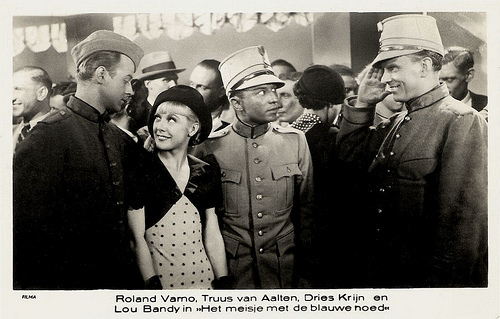
Dutch postcard by M. B.& Z. (M. Bonnist & Zonen, Amsterdam). Photo: Filma. Publicity still for Het Meisje met de Blauwe Hoed (1934) with Roland Varno , Truus van Aalten , Dries Krijn en Lou Bandy .
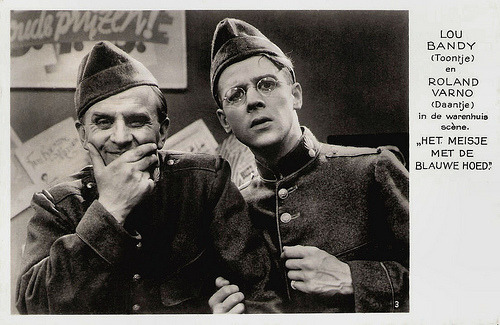
Dutch postcard by R.E.B., no. 3. Photo: publicity still for Het Meisje met de Blauwe Hoed/The girl with the blue hat (1934) with Lou Bandy and Roland Varno .
Scene from Het Meisje met de Blauwe Hoed/The girl with the blue hat (1934). Source: Kanaal van Johanpa3 (YouTube).
Scene from the TV series with André van Duin singing Vaste verkering. Source: Johnny Keurntjes (YouTube).
Sources: Henk van Gelder (Hollands Hollywood - Dutch), Kathinka Dittrich (Geschiedenis van de Nederlandse Film en Bioscoop tot 1940 - Dutch), Chip Douglas (IMDb), Wikipedia (Dutch) and IMDb.

Dutch postcard by M. B.& Z. (M. Bonnist & Zonen, Amsterdam). Photo: Filma.Publicity still for Het Meisje met de Blauwe Hoed/The girl with the blue hat (Rudolf Meinert, 1934) with Tony van den Berg and Roland Varno .

Dutch postcard by M. B.& Z. (M. Bonnist & Zonen, Amsterdam). Photo: Filma. Publicity still for Het meisje met den blauwen hoed/ The Girl with the Blue Hat (Rudolf Meinert, 1934) with Truus van Aalten . Collection: Egbert Barten. Comment by Ali Gardener at Flickr : "It looks like taken very spontaneous and still so perfectly posed! I like also the shadow of the shoes and all those splendid details."

Dutch postcard by M. B.& Z. (M. Bonnist & Zonen, Amsterdam). Photo: Filma. Publicity still for Het meisje met de blauwe hoed/The Girl With the Blue Hat (Rudolf Meinert, 1934) with Roland Varno . Collectie: Egbert Barten.
Unusual for the Netherlands
Het meisje met de blauwe hoed/The girl with the blue hat was an unusual production for the Netherlands in the 1930s. It was the first production by Filma, the film production company of 27 years old Wil Tuschinski, son of cinema chain owner Abraham Tuschinski. For the first time, a moving camera was used in the Cinetone Sound Film studios in Amsterdam. The production costs amounted to 100,000 guilders - a record for the Dutch film industry at the time.
The three stars were also interesting. Dutch-born actor Roland Varno (1908-1996) is best known for his role as one of the schoolboys in Josef von Sternberg's Der blaue Engel/The blue angel (1930). He appeared in several German and Dutch films of the early 1930s and then moved to Hollywood, where he made a film with Greta Garbo , As You Desire me (George Fitzmaurice, 1932). However, he mostly worked in Hollywood as a character actor, often in B-pictures.
The female leading role was played by another Dutch film star with a career abroad, Truus van Aalten (1910-1999). She starred in 29 European films during the 1920s and 1930s. She made most of them in Berlin and Vienna, and Het Meisje met de Blauwe Hoed/The girl with the blue hat was the only film she made in the Netherlands.
Singer and entertainer Lou Bandy (1890-1959) played a dual role in Het meisje met de blauwe hoed/The girl with the blue hat as Toontje and as himself. Bandy was one of the most popular artists of The Netherlands between the two world wars. His songs Zoek de zon op (Look for the sun) and Louise zit niet op je nagels te bijten (Louise, don't bite your nails) became Dutch evergreens. In this film, Bandy sings the songs In de petoet (In the brig) and Vaste verkering (Steady dating) which soon became hits in the Netherlands.

Dutch postcard by M. B. & Z. (M. Bonnist & Zonen, Amsterdam). Photo: Filma. Publicity still for Het Meisje met de Blauwe Hoed/The girl with the blue hat (Rudolf Meinert, 1934) with Lou Bandy .

Dutch postcard by M. B. & Z. (M. Bonnist & Zonen, Amsterdam). Photo: Filma. Publicity still for Het Meisje met de Blauwe Hoed/The girl with the blue hat (Rudolf Meinert, 1934) with Lou Bandy .

Dutch postcard by M. B. & Z. (M. Bonnist & Zonen, Amsterdam). Photo: Filma. Publicity still for Het Meisje met de Blauwe Hoed/The girl with the blue hat (Rudolf Meinert, 1934) with Eberhard Erfmann, Lau Ezerman , Gusta Chrispijn-Mulder, Tony van den Berg, Adrienne Solser, Roland Varno and Truus van Aalten .
Too wild for him
The film is also described as an army comedy. The story was based on a semi-autobiographical novel which Johan Fabricius published in 1927 and follows the story quite well. Roland Varno plays nerdy Daantje Pieters, who works in a grocery shop in Gouda when he is suddenly called to The Hague to serve for the Dutch army.
In the army, Daantje is the victim of teasing of his fellow soldiers. Especially his roommate Toontje ( Lou Bandy ) has great pleasure in keeping him fooled. The only thing that keeps Daantje going is the thought of 'the girl with the blue hat' ( Truus van Aalten ), a beautiful girl he spotted aboard the train to the garrison.
Despite the unfriendly beginning, smart and sneaky conman Toontje takes Daantje under his wing (not to mention his grocery supplies). During a visit to a revue of Lou Bandy Daantje notices again the girl with the blue hat. He is too shy to approach her, but Toontje arranges a meeting in a bar, to the chagrin of her date. The girl, who answers to the name Betsy, is attracted to Daantje and the two spend a romantic evening.
Daantjes mother (Adriënne Solser) is not impressed by the sexually liberated Betsy and sees her son would rather marry his neighbour Hilda Jansma (Tony van den Berg). Back in The Hague Betsy realizes that she and Danny do not fit together. She explains that she is too wild for him and breaks off the engagement.

Dutch postcard by M. B.& Z. (M. Bonnist & Zonen, Amsterdam). Photo: Filma. Publicity still for Het Meisje met de Blauwe Hoed/The girl with the blue hat (Rudolf Meinert, 1934) with Truus van Aalten .

Dutch postcard by M. B.& Z. (M. Bonnist & Zonen, Amsterdam). Photo: Filma. Publicity still for Het Meisje met de Blauwe Hoed/The girl with the blue hat (Rudolf Meinert, 1934) with Roland Varno and Truus van Aalten .

Dutch postcard by M. B. & Z. (M. Bonnist & Zonen, Amsterdam). Photo: Filma. Publicity still for Het Meisje met de Blauwe Hoed/The girl with the blue hat (1934) with Lou Bandy .
War Propaganda
During the Second World War, Het Meisje met de Blauwe Hoed/The girl with the blue hat was banned by the Nazis along with two other Dutch films, De Big van het Regiment/The Regiment's Mascot (Max Nosseck, 1935) and Ergens in Nederland/Somewhere in the Netherlands (Ludwig Berger, 1940) because of 'war propaganda'.
Chip Douglas at IMDb loves the film: "As a piece of Dutch cinema history this film is a clear standout. " About Varno and Van Aalten he notes: "They play their parts well, but it is Bandy who dominates the picture. His contribution, as well as the musical numbers managed to bring in a large enough audience to break even. However, writer Fabricius apparently wasn't very pleased when he found out they turned his book into a musical."
In 1972, a seven-part Dutch television series was broadcast, Het Meisje met de Blauwe Hoed/The girl with the blue hat (Dick van 't Sant, 1972) with Huib Rooymans, Jenny Arean and André van Duin in the lead roles. Rooijmans and Arean were married at the time, but divorced in 1973. Due to its length, the story was reworked and the very popular TV series contained more scenes and even more songs. Fabricius possibly turned in his grave.

Dutch postcard by M. B.& Z. (M. Bonnist & Zonen, Amsterdam). Photo: Filma. Publicity still for Het Meisje met de Blauwe Hoed (1934) with Roland Varno , Truus van Aalten , Dries Krijn en Lou Bandy .

Dutch postcard by R.E.B., no. 3. Photo: publicity still for Het Meisje met de Blauwe Hoed/The girl with the blue hat (1934) with Lou Bandy and Roland Varno .
Scene from Het Meisje met de Blauwe Hoed/The girl with the blue hat (1934). Source: Kanaal van Johanpa3 (YouTube).
Scene from the TV series with André van Duin singing Vaste verkering. Source: Johnny Keurntjes (YouTube).
Sources: Henk van Gelder (Hollands Hollywood - Dutch), Kathinka Dittrich (Geschiedenis van de Nederlandse Film en Bioscoop tot 1940 - Dutch), Chip Douglas (IMDb), Wikipedia (Dutch) and IMDb.
Published on May 29, 2015 22:00
Paul van Yperen's Blog
- Paul van Yperen's profile
- 13 followers
Paul van Yperen isn't a Goodreads Author
(yet),
but they
do have a blog,
so here are some recent posts imported from
their feed.



